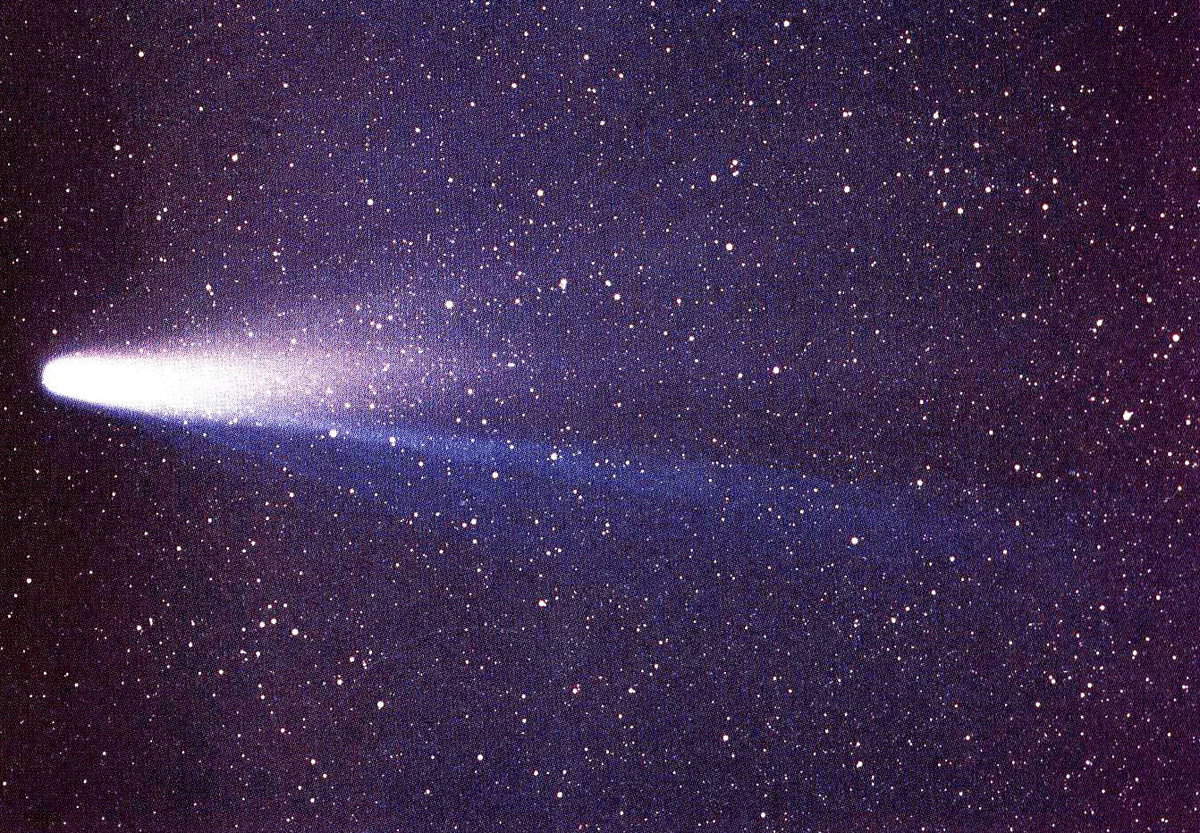Comet Halley is known as a fascinating and enigmatic celestial phenomenon. Each time this cosmic body approaches Earth, it brings with it an air of mystery. Scientists and astronomers have been unable to definitively establish a direct link between the appearance of this awe-inspiring comet and the occurrence of significant past events on our planet.
Halley’s Comet: its nature and renown
The term “comet” derives from the Greek word “komētēs,” meaning “hairy” or “shaggy.” This peculiar designation is attributed to their appearance, as these cosmic entities boast a distinctive silhouette and are comprised of a luminous coma-core (front section) measuring between 1 and 20 km, as well as an elongated tail. These celestial objects traverse the vastness of outer space in the direction of our star. Comets primarily consist of ice, frozen gases, and dust remnants from the formation of our solar system. To observe the movements of these celestial bodies in detail, the use of a telescope is imperative.
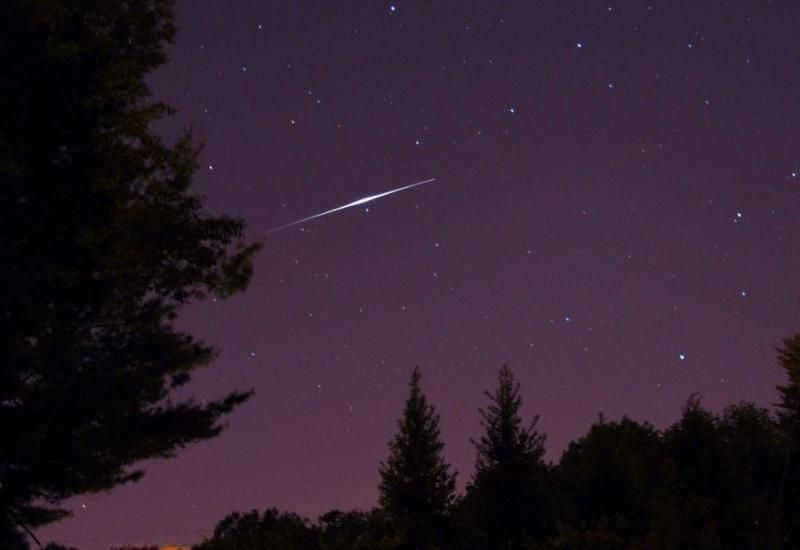
The comet of Halley is categorized as a short-period comet because it appears near the Sun every 75-76 years. Other celestial objects with similar characteristics but with an orbital period of more than 200 years are classified as long-period bodies. To determine the semi-major axis of Halley’s Comet, a simple astronomical task needs to be solved. The answer is 150,000,000 kilometers.
Halley’s Comet, as shown in the photograph, is one of the few astronomical objects that can be observed from Earth with the naked eye.
Here are some key details about this mysterious celestial body:
- It falls under the category of short-period comets.
- The predicted perihelion occurred in 1758 (the year of its discovery).
- Halley’s Comet has dimensions of 15 x 8km, with an average diameter of 11 km.
- The mass of Halley’s Comet is approximately 2.2 ⋅ 10^14 kg.
- The average density of Halley’s Comet ranges from 200 to 1500 kg/m^3, with an overall average of 600 kg/m^3.
- The diffuse surface reflectance characteristic of Halley’s Comet is 0.04.
Many individuals with a belief in mystical coincidences are curious about the next arrival of Halley’s Comet. This short-period celestial body makes a return to our solar system approximately every 75-76 years. As a result, the next approach to Earth is anticipated to occur on June 28, 2061.
Who discovered Halley’s Comet and when
The discovery of Halley’s Comet can be traced back to the Middle Ages when scientists began closely studying celestial bodies. However, the comet had been observed from Earth since ancient times. There is a theory that suggests the comet originally had a long-period orbit but was influenced by Saturn and Jupiter, causing its orbit to change. If this theory is correct, the comet likely originated from the outer reaches of the solar system.


After studying historical writings, Halley came to the conclusion that scientists of that time, including Apian in 1531, Kepler in 1607, and himself in 1682, had observed the same celestial object. Halley made a prediction that this object comes close to the Sun every 75-76 Earth years, taking into consideration the gravitational influence of the larger planets. He was the first to predict the comet’s return in 1758 and its visibility from Earth.
What is the eccentricity of Halley’s comet
The eccentricity of Halley’s Comet, one of the elements of its orbit, is given as the numerical value of 0.9671429. In simpler terms, this means that the comet follows an elliptical path around the Sun, with 0 representing a flat circle and 1 representing a parabolic orbit. During its previous return in 1986, the comet was closest to the Sun at a distance of 0.587 astronomical units, passing between the first two planets from the Sun. At its furthest point from the Sun, known as aphelion, the comet can reach a distance of 35 astronomical units, which is actually beyond the orbit of Pluto.
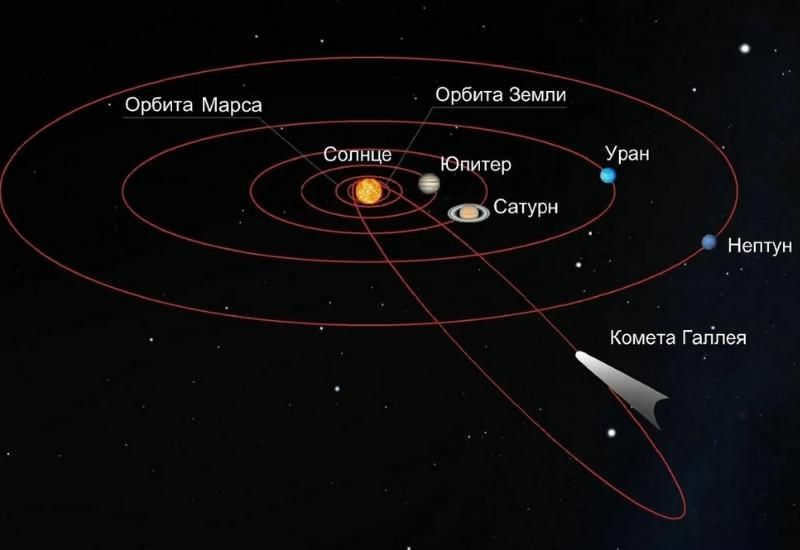
The inclination of the orbit to the ecliptic plane is 162.5 degrees, resulting in the galactic wanderer following a different path compared to other celestial bodies. By determining the inclination of the comet’s orbit in relation to Earth, astronomers can calculate the optimal location for spacecraft to closely study this relatively common visitor.
These calculations also reveal that the comet’s orbit has a significant eccentricity, indicating that it is one of the fastest known natural objects in space.
The duration of Halley’s Comet is widely recognized. It came closest to our star in 1986. The subsequent arrival of this celestial entity is expected in 2061. Astronomers have made certain calculations that suggest Halley’s galactic object orbits approximately every 16,000 to 200,000 years. The exact figure, however, cannot be definitively determined.
When was the last time Halley’s Comet was visible?
Many people are eager to know the date of the most recent sighting of Halley’s Comet. It made its last appearance in 1986. Astronomers from all over the world closely observed this celestial body. The Soviet Union utilized the Astron telescope, and artificial satellites, including those from the USSR’s Vega project, were also dispatched to study this galactic phenomenon. Although this event was considered extraordinary, it wasn’t particularly spectacular due to a simple reason: the comet and the Earth were in different hemispheres in relation to the sun. Therefore, it was actually impossible to spot this mysterious traveler.


Photographing Halley’s Comet from Earth was hindered by the smoky atmosphere. The celestial body reached its maximum brightness in April and March, but it was not visible. One of the first astronomers to spot the comet through a telescope was S. James O’Meara. He climbed Mount Mauna Kea, located on one of the Hawaiian Islands, and used a small 60 centimeter telescope to visually observe the “cosmic” visitor in the sky. At that time, the comet had a magnitude of 19.6.
In the 21st century, it is widely known that Halley’s Comet follows an elliptical path and makes periodic appearances near the sun. This phenomenon occurs every 75-76 years, and it presents a unique opportunity for astronomers and stargazers to observe the comet up close. To better understand the timing of Halley’s Comet’s next passage through its closest point to the sun, calculations can be provided. While new methods in studying the comet’s movement have emerged, the resulting data may not be entirely precise due to the use of approximate information.
Calculating the orbital period of Halley’s Comet (in years) is not a complex task. To begin, we need to select two consecutive dates when the comet passes through perihelion and is in orbit during one of the passages of the solar system’s most massive planets, Jupiter and Saturn. The measurement of Jupiter’s rotation should be done in terms of revolutions:
The other coordinate is inversely proportional to the major semi-axis. Subsequently, we can apply Kepler’s second law, also known as the law of areas. Finally, we can carry out the necessary calculations using recurrence formulas.
Origin of Halley’s Comet
Halley’s Comet is the sole celestial object with a short orbital period that is visible to the unaided eye. Numerous records in primary sources have documented at least 30 sightings of this cosmic phenomenon. The observers’ enthusiasm stemmed from the comet’s exceptionally radiant nucleus, which occasionally outshone Venus. The comet’s tail was also a remarkable sight, stretching across the sky and causing trepidation among ancient chroniclers. When the celestial wanderer appeared blurry and resembled a star of medium size, the historical accounts were brief.


According to historical records, Halley’s Comet was first mentioned in 240 BC. This bright and fascinating celestial wanderer was observed in China, ancient Russia, and Babylon. In the medieval period, the study of this cosmic visitor was conducted by Danish astronomer Tycho Brahe and Johannes Kepler. Isaac Newton also made significant contributions to the understanding of this celestial body, but it was Edmund Halley who took a particular interest in the comet. Halley carefully analyzed its movement and was able to prove its periodic appearance. As a result, the comet was named in his honor.
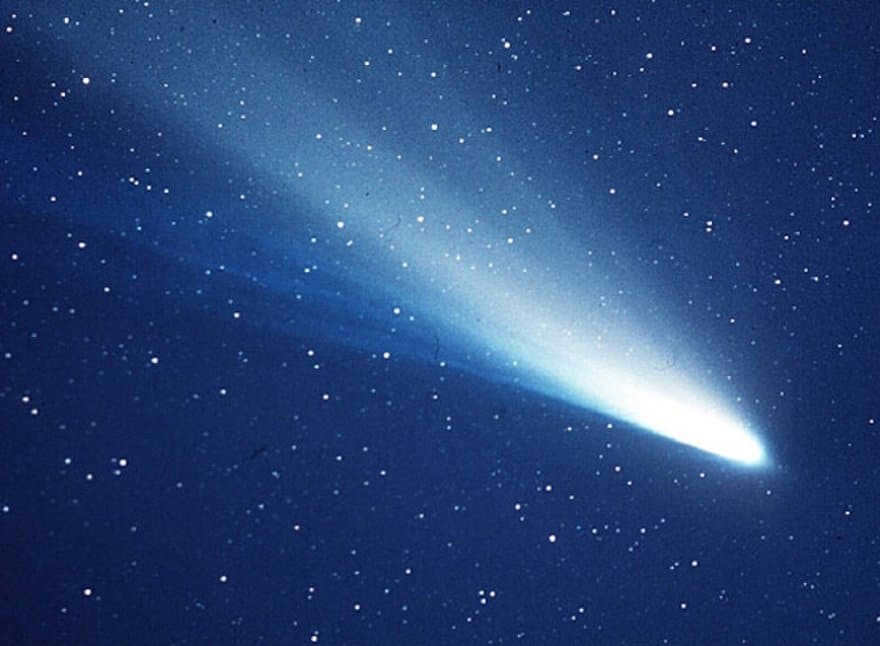
Halley’s Comet is a comet that belongs to our solar system. It has a unique orbital period and has been the subject of extensive research. The comet’s year, eccentricity, and major semi-axis are all important parameters that scientists study.
This fascinating celestial body visits our planet approximately every 75 years. The most recent sighting of Halley’s Comet was in 1986. If you’re curious about its next appearance, you can expect it to return in 2061.
The comet was named after Edmund Halley, a renowned scientist who diligently observed its arrival in 1531, 1607, and 1682. Through his meticulous research, Halley discovered that these three comets were actually a single object making periodic returns. As a result, he was able to accurately predict that the year 1758 would mark the arrival of Halley’s Comet.
Although Halley was unable to witness it, his findings were ultimately proven correct. Additionally, his calculations indicated that a specific type of comet was consistently making its way back to Earth. In 1986, Halley’s Comet was observed by telescopes on Earth, and certain spacecrafts even planned to collect samples from it.
Due to the lengthy duration of Halley’s Comet’s orbit, it is challenging to observe. As a result, scientists study other celestial bodies to compare and infer common characteristics. For instance, the analysis of 67P/Churyumov-Gerasimenko revealed that the composition of water on comets differs from that of Earth.
Halley’s Comet: A Journey Through History
The historical documentation of Halley’s Comet dates back to ancient times. The earliest record of the comet can be found in the Chinese chronicles Shin Shi and Wen Xiang Tung Khao, which were written around 239 B.C. The ancient Greeks also made note of the comet’s appearance in 466 B.C. Babylonian records from 164 and 87 B.C. further contribute to our understanding of the comet’s past orbital path. These ancient texts are of great significance as they provide valuable insights into the comet’s historical journey.

The appearance of Halley’s Comet in 1066 is depicted in the famous Bayeux Tapestry.
The arrival of the comet in 1301 served as an inspiration for the renowned artist Giotto who painted The Star of Bethlehem, a depiction of William the Conqueror’s triumph. During that time, astronomers believed that each comet sighting signaled the arrival of a new celestial object, often associated with impending calamities. This belief is also evident in Shakespeare’s play Julius Caesar, where one line suggests that comets are omens of royal deaths.
The revelation of the regularity of Halley’s Comet
Even in the era of Shakespeare, scientists were inclined to accept the notion that the Sun resided at the heart of the solar system. It required a significant amount of time before an influential idea emerged that revolutionized our perspective on our position in the cosmos (the heliocentric model).

In 1705, Edmund Halley completed his study of 24 comets and published the Astronomical Summary of Comets, in which he recorded the comets that appeared between 1337 and 1698. Among them, he identified three comets that shared similar orbits and characteristics, leading him to propose that they were actually the same comet. Additionally, Halley predicted that this comet would return in 1758.
True to his calculations, the comet arrived as expected in 1758, captivating scientists worldwide. The photograph below captures the awe-inspiring sight of Halley’s Comet.
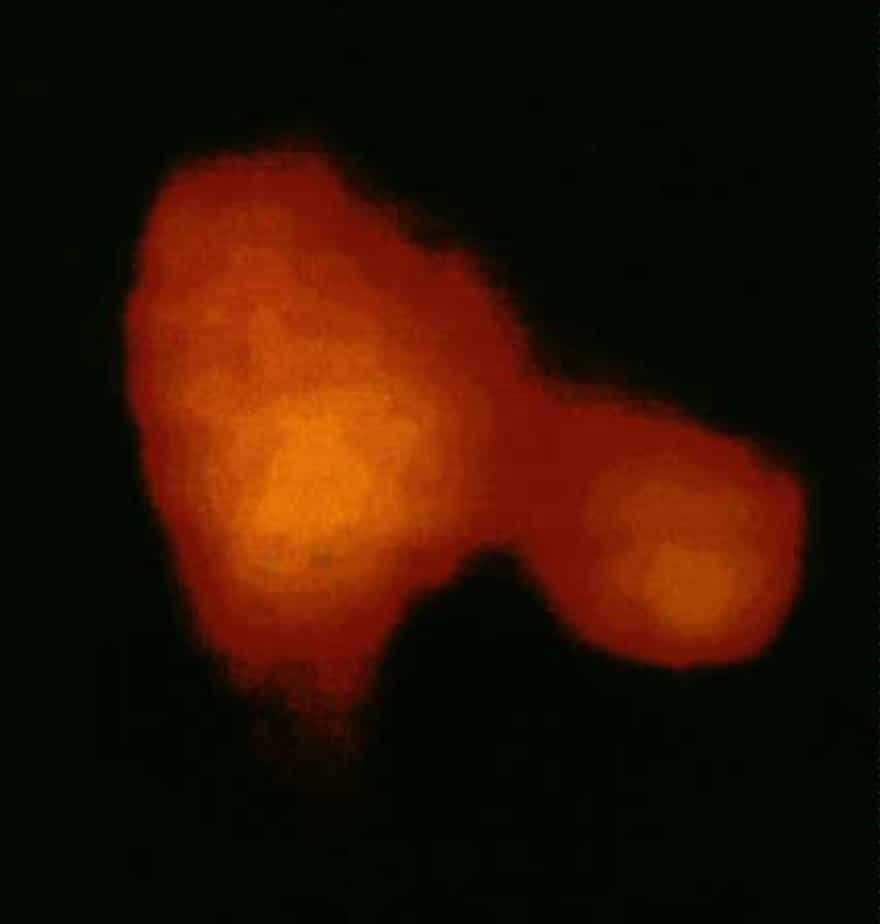

A picture of Halley’s Comet captured by the Russian Vega-2 spacecraft in 1986. Vega-1 approached the comet from a distance of 8,890 km, while Vega-2 came within 8,030 km.
The return of the comet in 1910 was particularly remarkable as it came 22.4 million kilometers closer to Earth. It was during that year that the first photograph of the comet was taken. It is astonishing that Mark Twain accurately predicted its return. He wrote that he arrived with the comet in 1835 and would depart with its next appearance. This prophecy came true on April 21, 1910.
Exploration of the Space Age
In the year 1986, mankind achieved a significant milestone by successfully sending spacecraft for exploration. This momentous occasion was particularly fortunate as it coincided with the close proximity of a celestial body. A fleet of spacecraft, collectively known as “Halley’s Armada,” was dispatched to study the comet. The Soviet-French mission, Vega-1 and 2, embarked on a journey to observe the comet, with one probe even managing to capture its nucleus. Additionally, two probes were launched from Japan to gather valuable data.
NASA’s International Cometary Explorer, which has been in operation since 1978, also contributed to the study of Halley’s Comet by providing photographs from a distance of 28 million kilometers.
Unfortunately, the arrival of the comet was marred by a tragic event. The crew of the Challenger STS-51L had planned to observe the comet, but on January 28, their ship exploded during takeoff, resulting in the loss of 7 astronauts.
We have many decades to wait for the next arrival, but we can monitor the remnants of the cosmos in space. Let’s focus on the Orionid meteor shower in October.
In 2061, Halley’s Comet will be on the same side of the Sun as Earth and will appear much brighter. Scientists are still uncertain about its periodicity because if it collides with any object, it will be pushed away for thousands of years.
It is anticipated that its brightness will reach an apparent magnitude of -0.3. Additionally, there are other objects that belong to the “Halley family comets” and share similar orbital characteristics. However, there are inconsistencies that suggest they may have a different origin. It is possible that they originate from the Oort cloud or were formed from the Centaurs, which are located between Jupiter and the Kuiper belt.
As they wait for the arrival of the comet, scientists are not wasting any time. From 2014 to 2016, we were fortunate enough to have the incredible chance to explore comet 67P/Churyumov-Gerasimenko and examine its samples. Similarly, researchers also investigated 81P/Wilde and 9P/Tempel.
Halley’s Comet Images
Photograph of Halley’s Comet in 1986
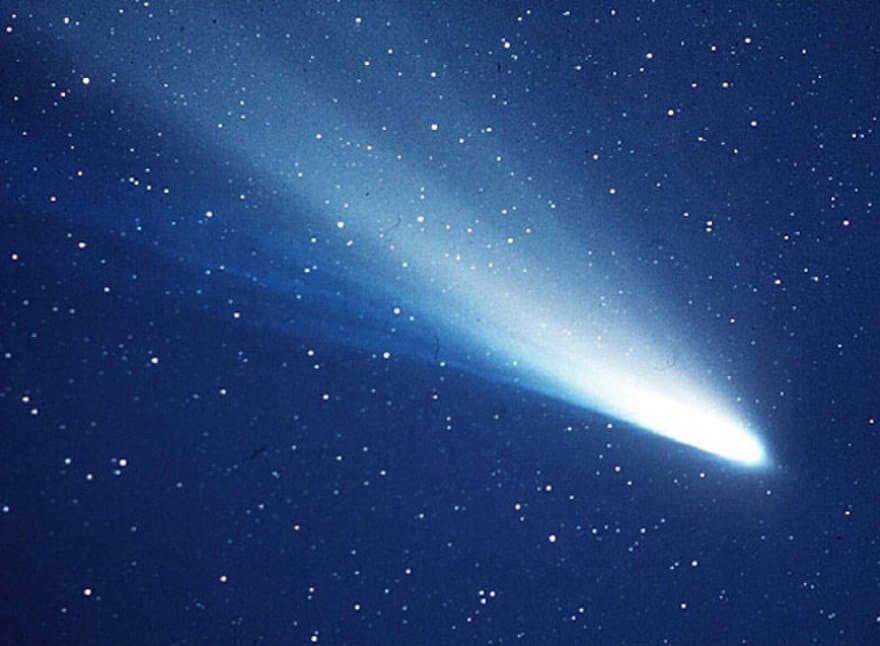
An image of Halley’s Comet taken in 1986.
Table Mountain Observatory captures the sight of the comet
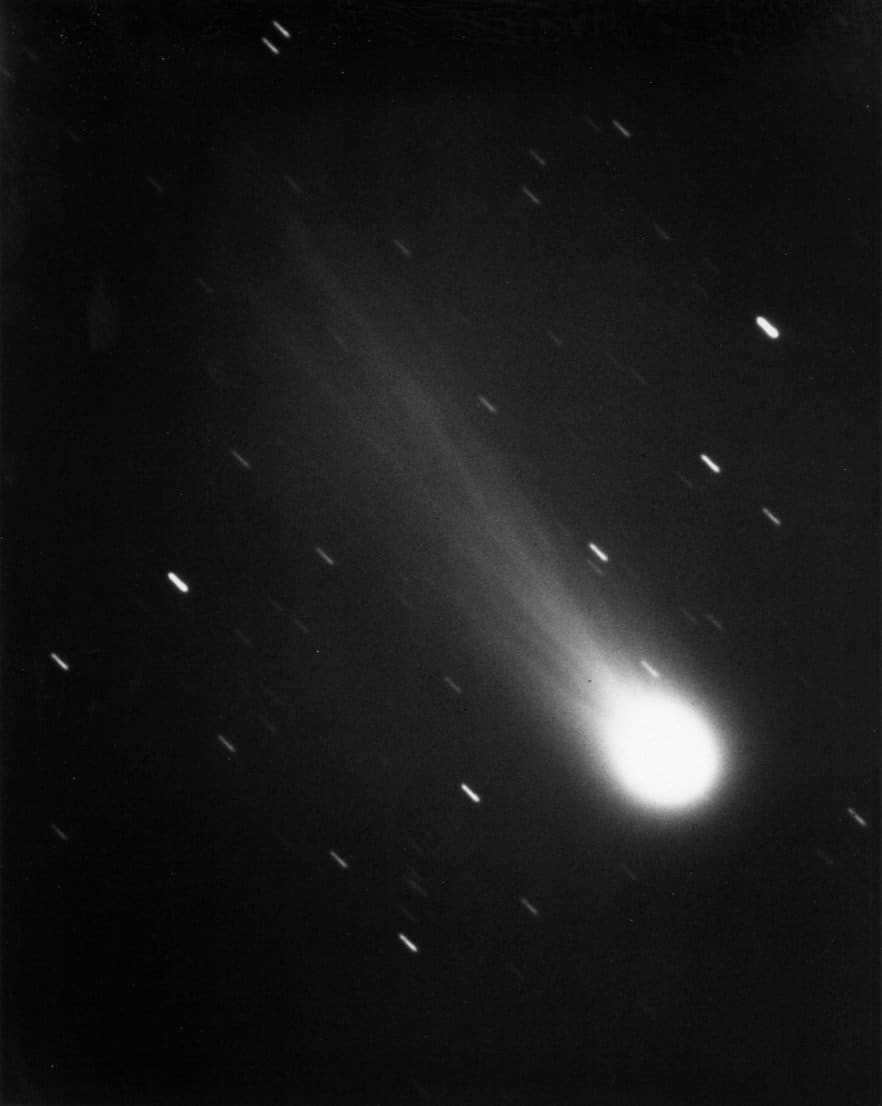
James Young managed to capture an image of Halley’s Comet on January 13, 1986, using a 24-inch reflecting telescope at the Table Mountain Observatory. The stars in Aquarius create the bands seen in the exposure. The image highlights the coma and the charged ion tail, which extends a remarkable 725,000 kilometers.
The Comet in 1910
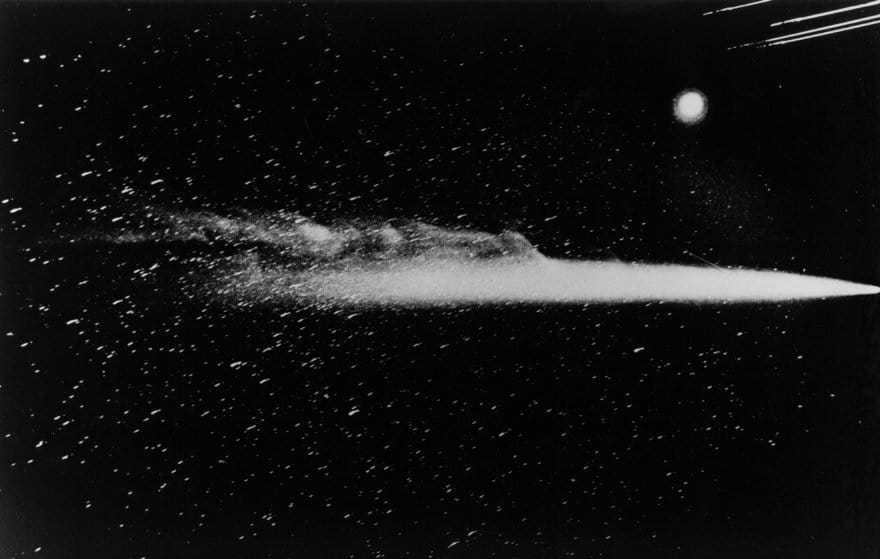

On May 13, 1910, the wide-angle camera at Lowell Observatory captured an image of the comet. A streak can be seen near the coma, indicating the path of a meteor. The lines at the lower right corner are the lights coming from the city of Flagstaff, while the bright spot above it is Venus.
The View of the Comet in Giotto’s Perspective
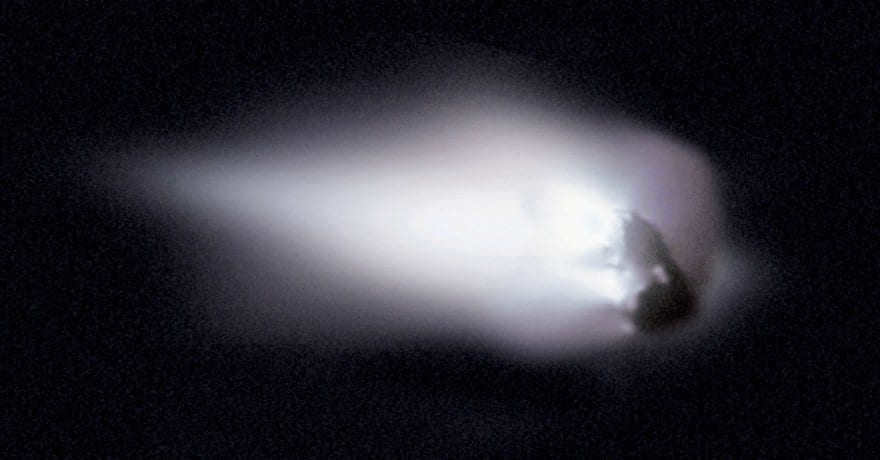
At a distance of 600 km, on March 13, 1986, the Giotto apparatus’s multicolor camera captured an image of a comet nucleus.
The Diamond Mountain Survey’s Observation of Halley’s Comet
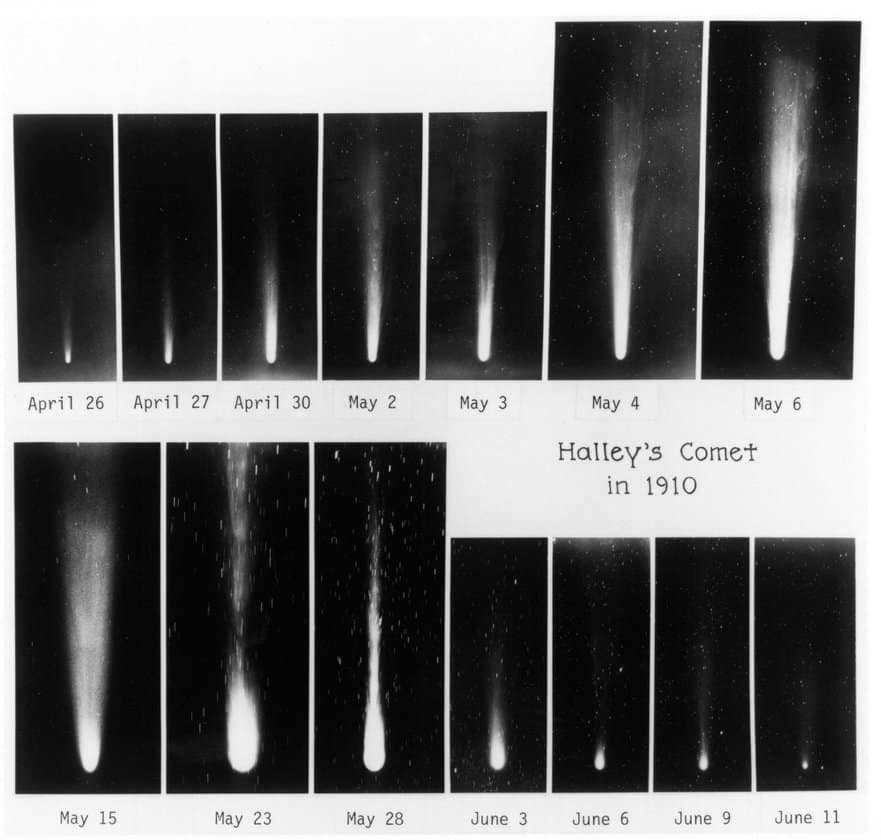
In 1910, Ferdinand Ellermann captured several images of Halley’s Comet from Diamond Mountain in Hawaii. The dots and short lines visible in the images are actually background stars.
Possibly, Halley’s Comet was successfully recorded during this time.
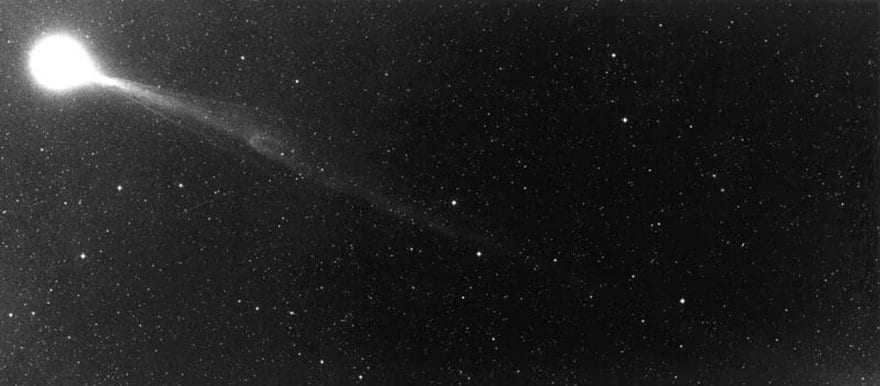

Eleanor Helin from LRD observed the tail of Halley’s Comet using Palomar Observatory’s 48-inch Schmidt telescope on December 13, 1985.
Halley’s Comet in the Mount Wilson Survey
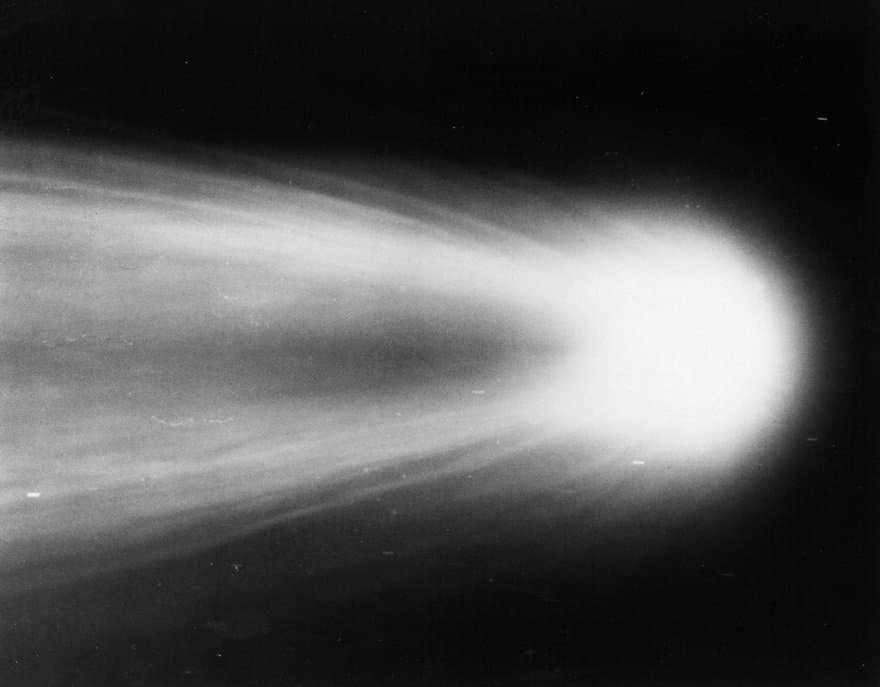

G. W. Ritchie from Mount Wilson Observatory managed to capture one of the final arrivals of the comet on May 8, 1910, through the utilization of a 1.5-meter telescope. This image shows the head and the initial section of the comet’s extended tail. The brief lines visible are the background stars.
Physical attributes of Halley’s Comet
| Discoverer: | First observed in ancient times; Named after Edmund Halley, who discovered its periodicity |
| Date of discovery: | First predicted perihelion occurred in 1758 |
| Alternative designations: | Halley’s Comet, 1P |
| Eccentricity | 0.9671429 |
| Semi-major axis | 2.66795 billion km (17.83414 a. e.) |
| Perihelion | 87.661 million km (0.585978 a. e.) |
| Aphelion | 5.24824 billion km (35.082302 a. e.) |
| Orbital period | 75.3 years |
| Orbital inclination: | 162.3° |
| Last perihelion: | February 9, 1986 |
| Next perihelion: | July 28, 2061 |
| Dimensions: | 15×8 km, with an average of 11 km |
| Mass: | 2.2-10^14 kg |
| Average density: | 600 kg/m^3 (estimates range from 200 to 1500 kg/m^3) |
| Albedo: | 0.04 |
| Meteor streams produced by. | Eta-Aquariids, Orionids |
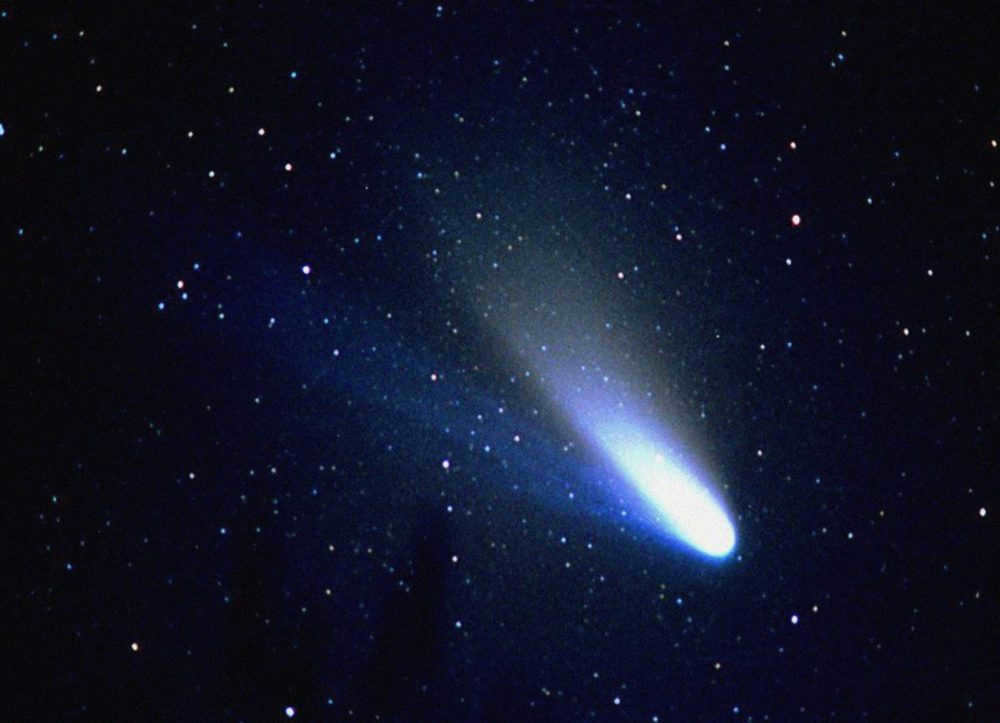
Throughout history, humans have been fascinated by the heavens, diligently searching for celestial signs that may foretell significant events on Earth. Some of these signs were seen as harbingers of good fortune and prosperity, while others were viewed as ominous omens of impending trouble. In addition to the predictable movements of the planets and their satellites, there exists another captivating celestial phenomenon that only graces our skies once every hundred years, eliciting fear and perplexity. These enigmatic objects are known as comets. In centuries past, comets were erroneously associated with bringing about famine, warfare, and outbreaks of disease.
Comet derives its name from the Greek word “hairy”. The reason behind this name is quite apparent: these celestial bodies possess a long, luminous plume that resembles a voluminous mane of hair or the tail of a horse. Furthermore, this plume always points away from the Sun, which can be easily understood as the solar wind deflects the tail. Throughout history, people have been closely observing the appearance of comets. In fact, over four hundred of them were detected prior to the invention of the telescope. Among the most renowned “tail stars” is undoubtedly Halley’s Comet.
It was named after the English scientist Edmund Halley, who calculated its orbit and determined its periodicity. Halley not only introduced the world to this comet, but also created the initial catalog documenting the movement of these extraordinary celestial objects.
The previous sighting of Halley’s Comet occurred on February 9, 1986. It is anticipated that the comet will make its next appearance in 2061, followed by another in 2134.
The arrival of Halley’s Comet in 1986 can be considered significant: it was the first time that scientists were able to study it using spacecraft. This led to the acquisition of valuable information about the comet’s nucleus structure, the formation of its tail, its rotational period, temperature, and more. The data obtained during this time were truly extraordinary.
Characteristic features, composition, and dimensions
Halley’s Comet is classified as a short-period comet, indicating that it completes its orbit around the Sun in less than two hundred years. The nucleus of this renowned comet has an irregular, potato-like shape and is composed of a combination of water, methane, ammonia, carbon, and other elements that are held together by the extreme cold of space. It is possible that the ice within the nucleus contains solid particles, primarily silicates. Spectral analysis has confirmed the existence of organic molecules, providing scientists with the basis to propose the hypothesis of the “cometary” origin of life on our planet.
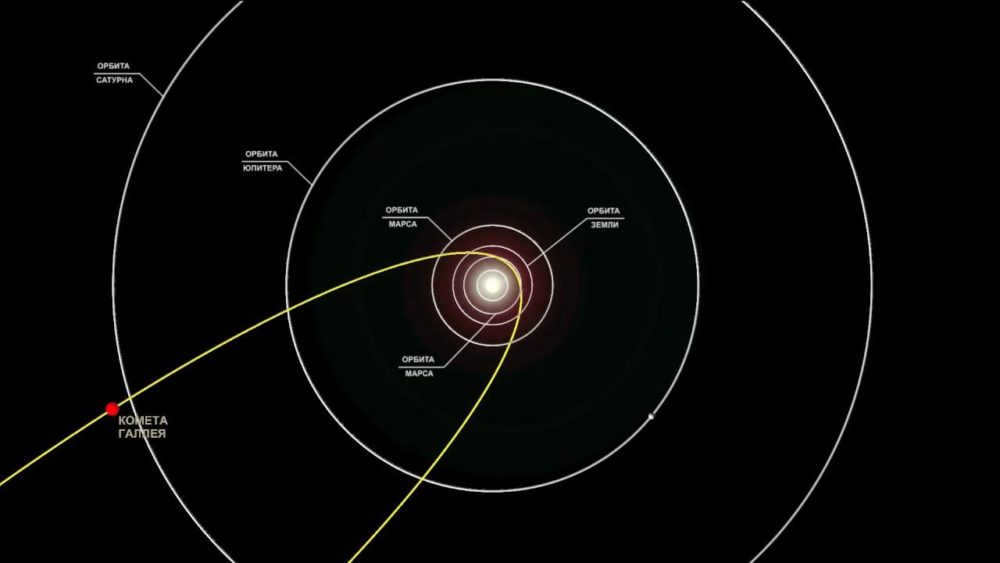
The dimensions of the celestial body are 15×8×8 km, however its mass is relatively small – 2.2⋅1014 kg. This signifies the fragility of the core, which is composed of a large number of individual fragments. Its average density is only 600 kg/m3 (water has 1000 kg/m3).
Information regarding the orbital period of Halley’s Comet varies: ground-based observations estimate the duration to be 7.4 days, whereas images obtained from spacecraft suggest a period of 52 hours. This variability is likely due to the irregular shape of the object and its complex topography.
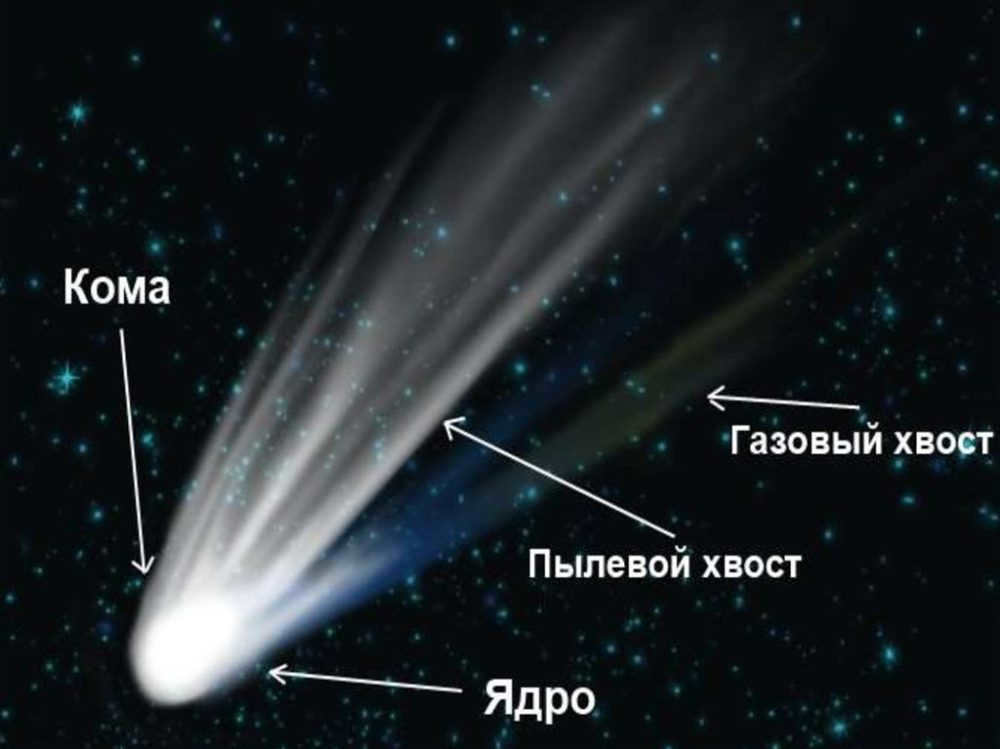
As the "snowball" gets closer to the Sun, it starts to heat up and undergoes intense destruction – the cometary matter transitions from a solid to a liquid state and then to a gaseous state. Gradually, a cloud made up of gas and dust forms around Halley’s comet’s nucleus, which astronomers refer to as a coma. The diameter of this coma can range from hundreds of thousands to a million kilometers. The comet becomes visible when it is 11 astronomical units away from the Sun.
The tail of Halley’s Comet, similar to other comets, is created by the pressure of the solar wind, which pushes gas particles from the coma far behind. The comet reaches its maximum brightness during perihelion passage, and as it moves away from the Sun, the luminosity gradually decreases until the “tail star” once again transforms into a gray and dull ball of ice and mud.
Orbit and Unique Characteristics of Movement
The cycle of movement for Halley’s Comet spans a duration of 75 to 76 years, occasionally varying between 74 and 79 years between each visit. This fluctuation is caused by the gravitational influence of the planets within the solar system that it passes near. The orbit of Halley’s Comet is an elongated ellipse with a high eccentricity of 0.967 and an inclination of 162.5 degrees to the plane of the ecliptic. The semi-major axis measures 2.66795 billion kilometers or 17.83414 astronomical units (a. e.).
During its most recent appearance in 1986, the comet reached its closest point to the Sun at 0.587 a. e. At its farthest point, known as aphelion, it was 35 astronomical units away from our star. While long-period comets of greater luminosity regularly grace the night sky, Halley’s Comet stands as the sole short-period comet that can be easily observed with the naked eye.
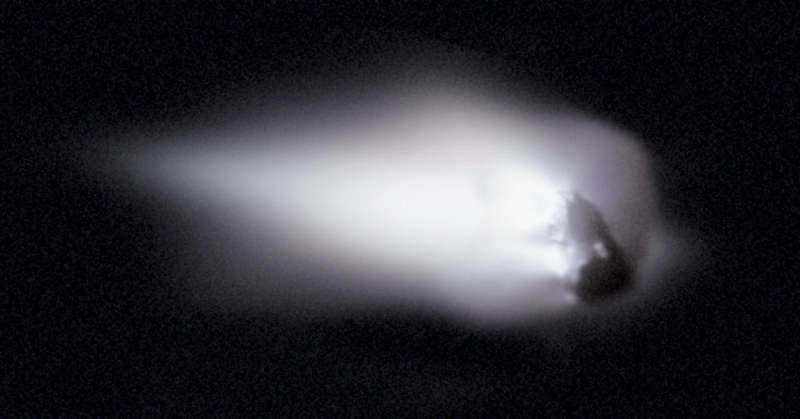
Scientists believe that Halley’s Comet originates from the Kuiper Belt, a region located between 30 and 50 astronomical units (a. e.) from the Sun. They estimate that it has been in its current orbit for anywhere between 16,000 and 200,000 years, although the exact age is difficult to determine due to the influence of gravitational forces. There is a hypothesis that the comet was previously a long-period comet, and its “home” was the Oort cloud, a mysterious sphere that surrounds our solar system.
Because of its highly elliptical orbit, Halley’s Comet has one of the highest speeds relative to Earth among all celestial bodies in our solar system, reaching approximately 70 kilometers per second.
The Harbinger of Trouble and Cataclysms
Every time Halley’s Comet made an appearance, it caused quite a commotion. It was always described in great detail in chronicles and historical records. Our ancestors simply couldn’t comprehend where this audacious violator of the unchanging celestial order came from, so they held no expectation of anything good coming from it.
In various cultures, the arrival of comets inspired similar associations. The Aztecs referred to them as smoky stars, the Chinese likened them to brooms, and many other civilizations saw them as tails or feathers. Almost universally, these celestial objects were believed to be messengers of unfortunate events or the consequences of committed crimes.
It is worth mentioning that the human race has always been fascinated by the nature of comets. There were two contrasting viewpoints on the matter. The Assyrians and Babylonians meticulously observed the constellations in the sky and believed that comets were fiery whirlwinds that originated in the atmosphere. On the other hand, ancient Greek philosophers considered comets to be genuine celestial objects, albeit peculiar and extremely rare ones. The renowned Aristotle completely dismissed the cosmic significance of comets. He argued that they were merely atmospheric phenomena unrelated to planetary motion. According to him, comets moved freely and did not adhere to the behavior expected of celestial bodies. Unfortunately, Aristotle’s unquestionable authority had a detrimental effect on the study of comets for many centuries, stifling progress in this field.

Naturally, there existed alternative viewpoints. For instance, Hippocrates of Chios not only acknowledged the extraterrestrial origin of comets, but also posited intriguing hypotheses regarding the periodicity of their motion, as well as the nature of their renowned tail. The Roman philosopher Seneca concurred with Hippocrates, offering a straightforward and efficacious approach to studying these celestial bodies: amassing observational data on their previous apparitions in the heavens. A millennium and a half later, Edmund Halley followed this course.
The advent of Halley’s Comet served as a catalyst for the artist Giotto to create a masterpiece known as the Star of Bethlehem, a symbol of the triumph of William the Conqueror. This celestial event is also depicted in the renowned Bayeux tapestry, portraying the Norman invasion of England. It is important to note that during this era, not all scientists perceived the return of each comet as the arrival of a novel entity. In fact, William Shakespeare alludes to these cosmic phenomena as omens of regal demise in his play Julius Caesar. Nonetheless, it was primarily astrologers who held a fascination for comets during the medieval period.

The exploration of Halley’s Comet commenced during the modern era. Paolo Toscanelli, an Italian astronomer, conducted research on the comet. In 1577, the renowned Tycho Brahe successfully refuted the “atmospheric” hypothesis regarding comets by calculating the distance to one of them. The findings revealed that the orbit of the object was significantly further than that of the Moon.
In 1531, Peter Alian made an observation that the tail of a comet is consistently pointed in the opposite direction of the Sun. This led him to hypothesize a connection between the comet and sunlight. When Kepler observed Halley’s Comet in 1607, he did not believe that these objects had a predictable pattern and thought they moved in a straight line. The study of this question was further advanced by Girolamo Fracastoro, Peter Apian, Giovanni Borelli, and Jan Hevelius. However, it was the English scientist Edmund Halley who made the most significant breakthrough in this field.
The person after whom the comet was named
In 1680, a young astronomer named Halley discovered that comets move periodically in the solar system. However, he was unsure about the exact nature of their orbits. To find answers, Halley sought the help of Newton, who had dedicated many years to studying the motion of celestial bodies.
It can be said that the collaboration between these two exceptional individuals led to the creation of Newton’s famous work, “Mathematical Beginnings of Natural Philosophy.” The first edition of this work was funded by Halley. It formulated the laws of gravitation and celestial mechanics, providing the basis for the theory of comet motion.

By applying Newton’s laws, Halley managed to create the initial compilation of comet orbits. He arrived at the conclusion that the comets observed in 1680 and 1681 were actually one and the same object before and after its close encounter with the Sun. The scientist observed significant similarities in the paths of multiple comets observed in different years. The astronomer proposed that the comet observed in 1531 by Appian, in 1607 by Kepler, and in 1682 is in fact the identical celestial body with a period of revolution of 75 years. Based on this, Halley calculated the predicted timing of the next appearance of this celestial body near Earth, and arrived at the year 1758.
Despite not living to see the confirmation of his assumptions, the scientist’s predictions were brilliantly validated. In 1758, on Christmas night, a German amateur astronomer named Johann Georg Palich discovered the comet that Halley had predicted, and he promptly alerted the world to this momentous finding. The comet reached its closest point to the sun, known as perihelion, on March 13, 1759. Just before this extraordinary event, a team of French scientists, led by astronomer Clerot, refined the comet’s orbit parameters, taking into account the gravitational influences of Saturn and Jupiter. This adjustment ultimately caused a delay in the comet’s appearance, amounting to 618 days.
The first proof that the Sun is not the only celestial body around which planets orbit came from successfully predicting the return of the comet. This further validated Newton’s laws of celestial mechanics and showcased their ability to make accurate predictions. As a tribute to the astronomer who discovered its orbit, the comet was named after Edmund Halley by the French astronomer Lacaille in 1759.
The discovery of Halley holds a special place in the history of astronomy, as it was the first predicted comet to be discovered and remained the only one for almost a century and a half. It wasn’t until the early 19th century that Johann Enke managed to accurately predict another comet.
Around the same time, scientists also discovered another mechanism that affects the parameters of cometary orbits. They found that the speed of a comet can change due to the reactive thrust of gases that are released from it under the influence of sunlight. This change in speed can cause the period of the comet’s orbit to either increase or decrease.
In the subsequent years, the return of Halley’s comet to Earth occurred with consistent regularity, captivating astronomers who dedicated themselves to its investigation. Moreover, each successive forecast regarding the appearance of the “tail star” became increasingly precise.
Additionally, astronomers endeavored to rewind time and showcase the early occurrences of Halley’s Comet by analyzing observations documented in historical records. In pursuit of this objective, they meticulously examined Chinese and European chronicles. Prominent individuals involved in such research include Cowell and Crommelin. During the early 20th century, they successfully computed the celestial body’s visits up until 1301, achieving remarkable accuracy. Russian astronomer Viliev delved into the examination of the object’s presence during the time period spanning from 451 AD to 622 BC.
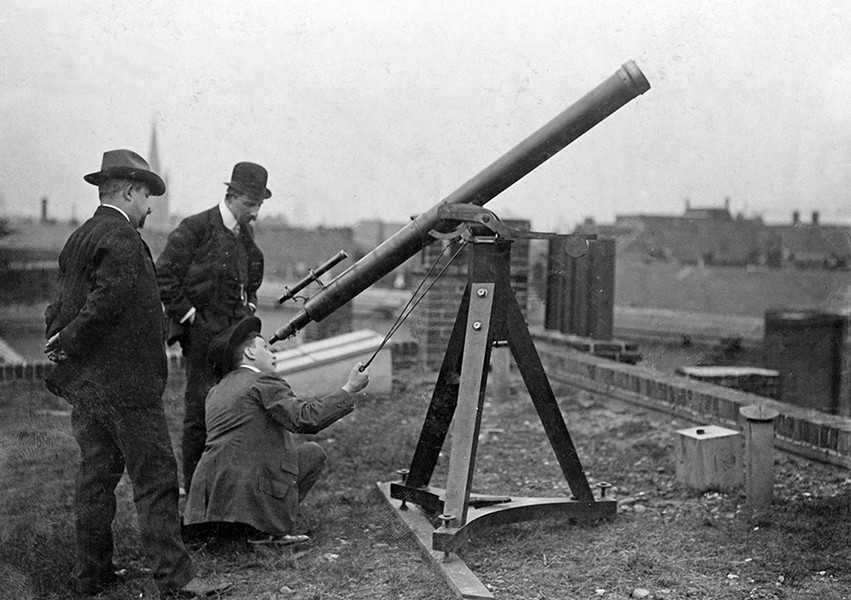

The arrival of Halley’s Comet in 1835 was a relatively unremarkable event, capturing the attention of only a select group of astronomers. However, its next appearance was truly extraordinary and triumphant. In 1910, the imminent arrival of the “death star” was widely publicized by the media, causing a genuine frenzy in society. Prior to its arrival, scientists had detected cyanides in the comet’s tail, substances with well-known toxic properties. Furthermore, calculations indicated that Earth was destined to pass through the tail during this encounter. Additionally, rumors circulated that the comet carried unknown and potentially deadly bacteria, which would surely prove fatal to those not already succumbing to cyanide poisoning.
A wave of panic was unleashed, fueled by the media. Fear gripped the population, leading to suicides and a surge in the demand for “comet pills” and protective umbrellas. This overblown hysteria even found its way into literature, as evidenced by Conan Doyle’s 1913 novel, The Poisoned Belt.
For astronomers, 1910 was a true celebration: they were extremely well-prepared to welcome the “celestial visitor” after years of observation. This visitor came as close as 0.15 astronomical units to Earth. The comet was visible from all corners of the world, and scientists worldwide took full advantage of this opportunity. Moreover, it was the first time that science had a chance to study this fascinating object using spectroscopic methods, which provided additional information about its composition. Scientists discovered that the comet’s composition included hydrogen, carbon, oxygen, various metals, nitrogen, and silicates. They captured about 500 photographs and obtained over 100 spectrograms.
The information acquired in 1910 proved invaluable for organizing the exploration of the comet using spacecraft in 1986.
Observing the comet from a space perspective
With the advent of the space age, scientists gained access to new tools for studying “comet tails”. The first photographs of comets from space were taken in 1970. Then, in 1982, the International Sun-Earth Explorer 3 was dispatched to study a comet.
However, the real breakthrough in scientific research occurred in 1986, when a fleet of spacecraft was sent to investigate Halley’s comet:
- “Vega-1” and “Vega-2” (USSR)
- “Giotto” (European Space Agency)
- “Susei and Sakigake” (Japan)
The preparations for the object’s rendezvous started several years prior to its arrival. Astronomers at the Palomar Observatory observed the return of Halley’s Comet on October 16, 1982. The mission of the Soviet “Vega” apparatuses consisted of two components. The first stage aimed to explore the surface of Venus and study the dynamics of its atmosphere, while the second stage involved flying near the comet to gather diverse scientific data about it.
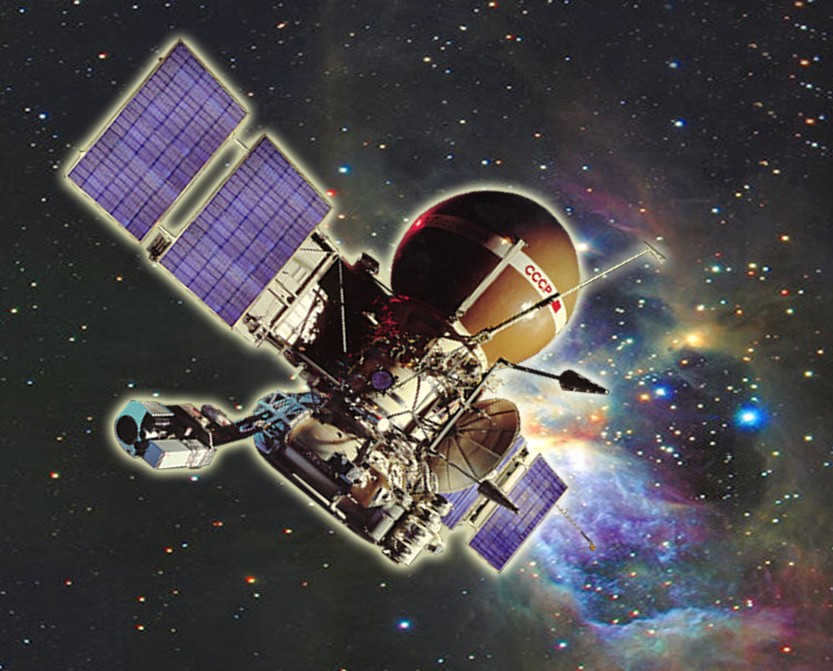
The data gathered by the Soviet instruments was utilized to correct the trajectory of the European probe “Giotto”. Thanks to this, it was able to approach the object at an unprecedented distance of 605 kilometers. However, prior to this, the probe’s camera had malfunctioned, slightly disrupting the expedition’s plans. Even earlier, the Japanese spacecrafts “Suisei” and “Sakigake” had approached the comet.
“Vega” is regarded as one of the most successful projects in the history of global astronautics. It is worth mentioning that this remarkable achievement was made possible by the close collaboration of multiple countries, a practice that had not been implemented on such a large scale before.
Research conducted after 1986
Following its previous sighting, investigations into Halley’s Comet persisted. On the 12th of February, 1991, the comet commenced an abrupt emission of material that endured for multiple months. It discharged an immense dust cloud measuring roughly 300 thousand kilometers in diameter.

In March 2003, scientists last observed Halley’s Comet. During that time, its magnitude in the night sky was 28.2m, and it had already covered about 80% of its total distance towards aphelion, the farthest point of its orbit. Ground-based telescopes were able to detect the comet from a remarkable distance of 28.06 astronomical units and at its faintest apparent magnitude. Presently, scientists have the capability to observe Halley’s Comet at any stage of its orbital path. For instance, on October 3, 2014, the comet was located in the Hydra constellation at a distance of 34 astronomical units from our Sun, which is even beyond the orbits of Neptune and Pluto. In the near future, the comet will reach its maximum distance from the Sun, expected to occur in December 2023, after which it will begin its journey back towards the Sun.
Anticipated Dates for the Upcoming Appearances
It is predicted by scientists that the next appearance of Halley’s Comet will occur around July 28, 2061. This event is expected to be an extraordinary occurrence in the field of modern astronomy, as the perihelion of the comet and the Earth will both be on the same side of the Sun. Experts at NASA are confident that the comet will be visible to the naked eye for a period of four months during its 2061 visit. Undoubtedly, people on Earth will have the opportunity to witness a breathtakingly beautiful spectacle, particularly during the early morning and evening hours.
The estimated apparent magnitude of the comet expected in 2061 is -0.3, indicating its brightness. In comparison, the magnitude was +2.1m in 1986. On September 9, 2060, it will come close to Jupiter at a distance of 0.98 astronomical units, and in August 2061, it will approach Venus at a distance of 0.0543 astronomical units. Once it passes perihelion, Halley’s Comet will vanish from our view and travel into the vast darkness of space. Its next appearance is predicted for 2134, with perihelion occurring on March 27. On May 7, it will come near Earth at a distance of 0.09 astronomical units. During this time, its apparent magnitude will be roughly -2.0m.
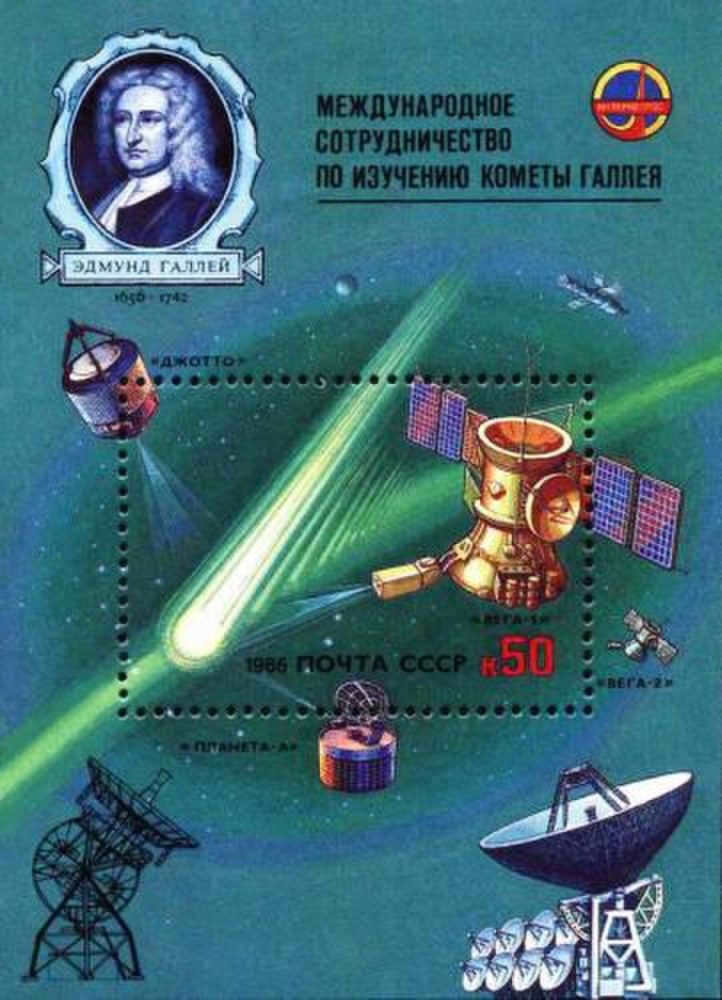
Centuries of diligent research have not been futile. Presently, we possess a vast amount of knowledge concerning the essence of Halley’s Comet, yet there remain inquiries that necessitate further elucidation. Among these inquiries are the factors that instigate sudden bursts of luminosity, the peculiar behavior of the comet’s tail, which can expand even at a considerable distance from the Sun. There exists a theory regarding the existence of an autonomous energy source, which we desire to verify. Moreover, the process of the comet nucleus’s division, as observed in 1910, remains somewhat enigmatic. Additionally, certain aspects of the object’s orbit raise questions.

In our solar system, in addition to the planets and their moons, there exist celestial bodies that captivate the scientific community and captivate the general public. Among these, comets hold a special place. They bring vibrancy and movement to our Solar System, transforming the nearby space into a playground for exploration. The arrival of these cosmic wanderers is always accompanied by spectacular astronomical events that can be witnessed even by amateur stargazers. One of the most renowned visitors is Halley’s Comet, a celestial object that makes regular appearances in close proximity to Earth.
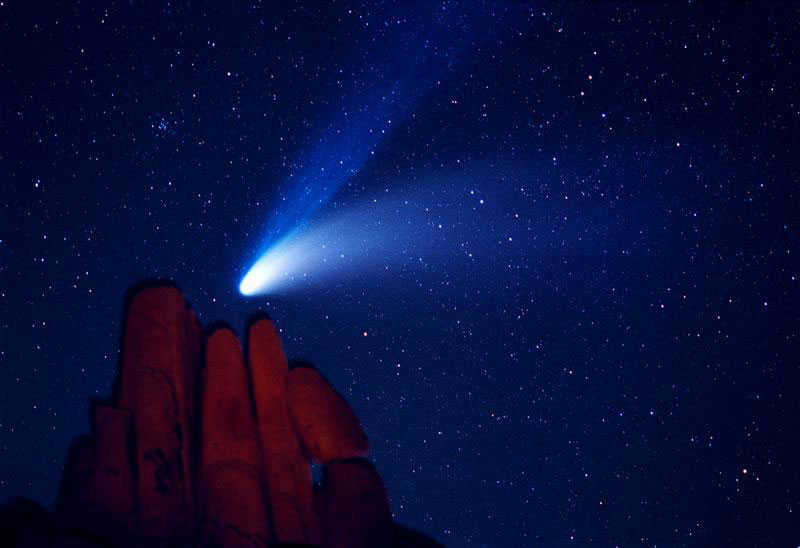
In February 1986, Halley’s Comet made its most recent appearance in our vicinity of space. It briefly graced the sky in the constellation Aquarius before vanishing behind the brightness of the sun. During its perihelion passage that year, the comet was visible from Earth for a short period of time. The next anticipated visit from this famous celestial visitor is scheduled for 2061. Will Halley’s Comet once again make its grand and dazzling return after 76 years?
When Humanity First Became Aware of Halley’s Comet
The occurrence of comets in our Solar System is a relatively rare event, happening on average once every 200 years. Throughout history, the arrival of these celestial visitors has sparked a range of emotions in people, with some feeling anxious and others filled with awe and wonder. The scientific community, in particular, has always been fascinated by these cosmic phenomena.
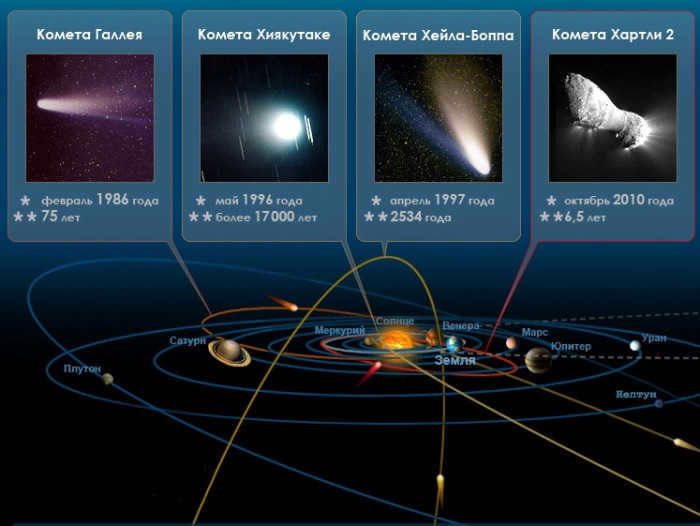
For other comets, their visits to our solar system occur infrequently. These celestial bodies enter our vicinity approximately once every 200 years. Due to their infrequent appearances, it is difficult to determine their precise astronomical characteristics. Throughout human history, comets have been a constant presence.
For a considerable period, humanity lacked knowledge regarding the true nature of this astrophysical phenomenon. It was only in the early 18th century that a systematic exploration of these fascinating cosmic entities could commence. The initial celestial body to provide reliable information was Halley’s Comet, which was discovered by the esteemed English astronomer Edmund Halley. What made this comet particularly noteworthy was its conspicuous visibility to the unaided eye. Leveraging the observations made by his predecessors, Halley was able to ascertain that this celestial wanderer had visited the solar system on three separate occasions. According to his calculations, the same comet had graced the night sky in the years 1531, 1607, and 1682.

After numerous years of studying this phenomenon, a rough schedule has been compiled regarding its future appearances. Although the lifespan of a human is fleeting in comparison, Halley’s Comet only graces us with its presence every 74-79 Earth years. Nevertheless, scientists eagerly anticipate the arrival of this celestial traveler, as observing its mesmerizing journey and the accompanying astrophysical phenomena is considered a great fortune within the scientific community.
Astrophysical characteristics of the comet
Aside from its frequent appearances, Halley’s Comet possesses a plethora of intriguing features. It is the sole extensively researched celestial body that, during its approach towards Earth, moves in the opposite direction alongside our planet. The same orbital parameters are observed in relation to the movements of other planets within our solar system. Consequently, there exists a significant opportunity to observe this comet as it travels in a highly elongated elliptical orbit in the opposite direction. With an eccentricity of 0.967 e, its orbit ranks among the highest in the entire solar system. Only Nereid, a moon of Neptune, and the dwarf planet Sedna boast orbits with similar parameters.
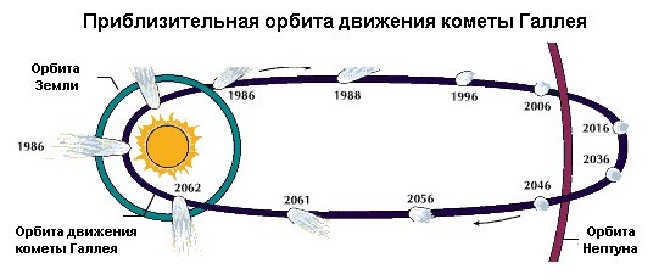
The elliptical path of Galle’s comet has the subsequent characteristics:
- the length of the major semi-axis of the orbit amounts to 2.667 billion kilometers;
- at the closest point to the Sun, the comet is located 87.6 million kilometers away;
- when Galle’s comet passes near the Sun at its farthest point, the distance to our star is 5.24 billion km;
- the average duration of the comet’s orbit on the Julian calendar is 75 years;
- Galle’s comet has an orbital velocity of 45 km/s.
The information about the comet mentioned above was discovered through observations conducted over the course of a century, from 1910 to 1986. The comet, due to its highly elongated orbit, passes by us at an astonishing speed of 70 kilometers per second, making it the fastest space object in our solar system. In 1986, Halley’s Comet provided valuable insights into its composition and physical characteristics. These findings were obtained through direct contact with the celestial body by automated probes. The probes were part of the spacecrafts called “Vega-1” and “Vega-2”, which were specifically launched to explore this intriguing space visitor.
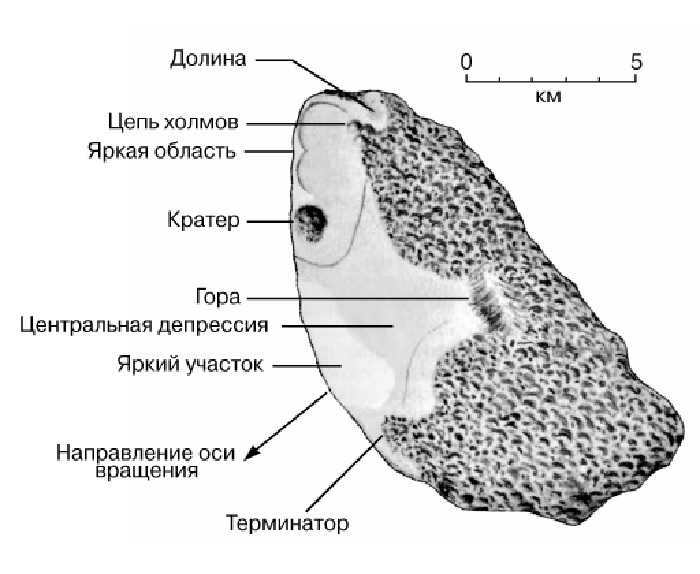
Contrary to previous expectations, the comet’s physical parameters indicate that it is not as large as initially thought. The irregularly shaped celestial body measures 15×8 km, with a maximum length of 15 km and a width of 8 km. Its mass is estimated to be 2.2×1024 kg. In terms of size, this comet can be classified as a medium-sized asteroid within our solar system. Its density is 600 kg/m3, which is lower than the density of water in its liquid state (1000 kg/m3). It is important to note that the density of the comet’s nucleus may vary depending on its age, and the latest data available is from its last visit in 1986. Therefore, it is uncertain whether the comet will maintain the same density when it next arrives in 2061. Due to its continuous loss of weight and potential for collapse, it is possible that the comet may eventually disappear.
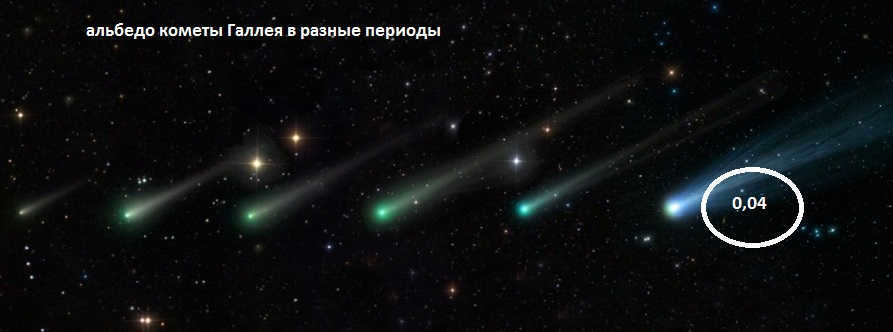
Halley’s Comet has a low albedo of 0.04, similar to charcoal. This means that the nucleus of the comet is a dark cosmic object with a weak ability to reflect sunlight. The comet only becomes visible because of its fast motion, which creates a bright and stunning effect.
As it travels through the vastness of the solar system, Halley’s Comet is accompanied by meteor streams called Aquarids and Orionids. These natural phenomena occur when the comet’s body is destroyed, and the intensity of both events can increase with each subsequent passage of the comet.
Versions on the Origin of Halley’s Comet
According to the accepted classification, Halley’s Comet, our most well-known celestial visitor, falls under the category of short-period comets. These comets are characterized by a small orbital inclination in relation to the ecliptic axis (only 10 degrees) and a short orbital period. Typically, such comets belong to the Jupiter family of comets. However, Halley’s Comet, along with other similar celestial bodies, stands out significantly in terms of its astrophysical parameters. Consequently, these objects have been classified as a distinct type known as the Halley type. Currently, scientists have identified only 54 comets of the same type as Halley’s Comet that have passed through near-Earth space throughout the entire existence of the solar system.
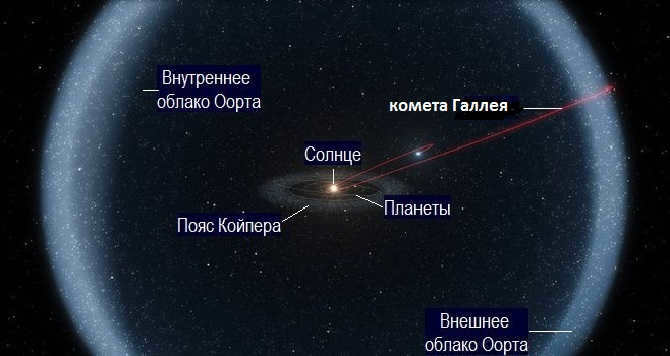
It is believed that these celestial entities were previously classified as long-period comets and only transitioned to another category due to the gravitational influence of the gas giant planets: Jupiter, Saturn, Uranus, and Neptune. In this scenario, our current regular visitor could have originated in the Oort cloud, which is a distant and mysterious region of our solar system. There is also an alternative theory regarding the origin of Halley’s Comet. It is possible for comets to form in the boundary area of the Solar System, where trans-Neptunian objects reside. Based on numerous astrophysical parameters, the small bodies in this region bear a striking resemblance to Halley’s comet. Specifically, their retrograde orbits closely resemble that of our celestial guest.
Preliminary calculations indicate that the celestial body, which visits our vicinity every 76 years, has been in existence for over 16,000 years. It is clear that the comet has been traveling along its current orbit for a considerable amount of time. However, it is impossible to determine if the orbit has remained the same for the past 100-200 thousand years. The flying comet is constantly influenced by various forces, not just gravitational ones. Its nature makes it susceptible to mechanical effects, which in turn result in a reactive effect. For instance, when the comet is at aphelion, the heat from the sun causes the surface to heat up. This heating process leads to the sublimation of gas, creating flows that act like rocket engines. As a result, the comet’s orbit oscillates, causing deviations in the orbital period. These deviations become apparent at perihelion and can range from 3-4 days.
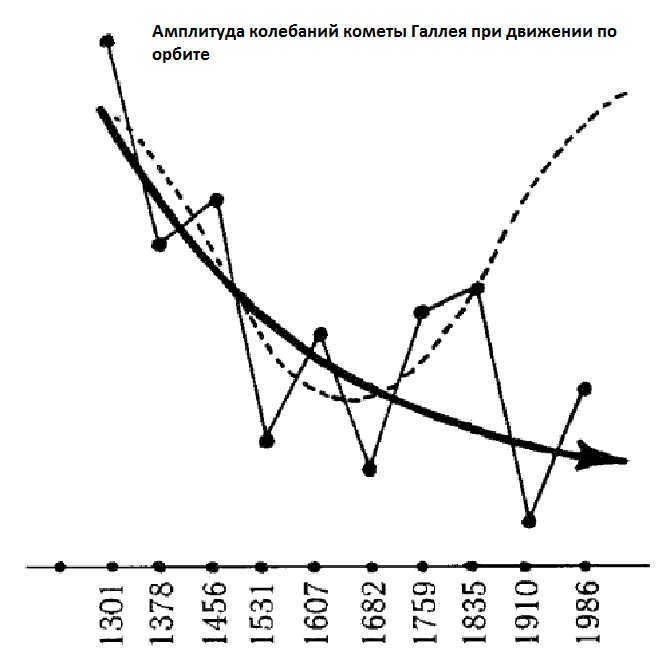
The Soviet automatic spacecraft and vehicles from the European Space Agency came close to missing their rendezvous with Halley’s Comet in 1986. It was impossible to predict and calculate the potential deviations in the comet’s orbital period, which caused the comet to oscillate in its orbit. This finding supports scientists’ hypothesis that the period of Halley’s Comet’s orbit can change in the future. This raises questions about the composition and structure of comets. The initial theory that comets are massive blocks of space ice is contradicted by the long existence of comets that have not evaporated or dissipated in outer space.
The core of Halley’s Comet was initially examined at close proximity by automated space probes. Whereas before, individuals could only observe our visitor through a telescope, gazing at it from a distance of 28.06 astronomical units, now we have obtained images from a minimum distance of slightly over 8000 km.
In fact, it transpired that the core of the comet possesses a relatively diminutive magnitude and bears a resemblance to a typical potato tuber in its appearance. Upon examining the density of the core, it becomes apparent that this celestial entity is not a solid mass, but rather a conglomeration of debris of cosmic origin, firmly bound together by gravitational forces into a unified structure. The colossal stone block is not merely traversing outer space, careening in various directions. The comet boasts a rotational motion, which, according to different sources, takes approximately 4-7 days. Furthermore, this rotation is oriented in the same direction as the comet’s orbital path. Based on the imagery, it can be inferred that the core possesses intricate topography, featuring both depressions and hills. Additionally, a cosmic crater has been discovered on the surface of the comet. Despite the limited amount of information gleaned from the images, it is conceivable that the core of the comet constitutes a sizable fragment of another massive celestial body that once existed in the Oort cloud.
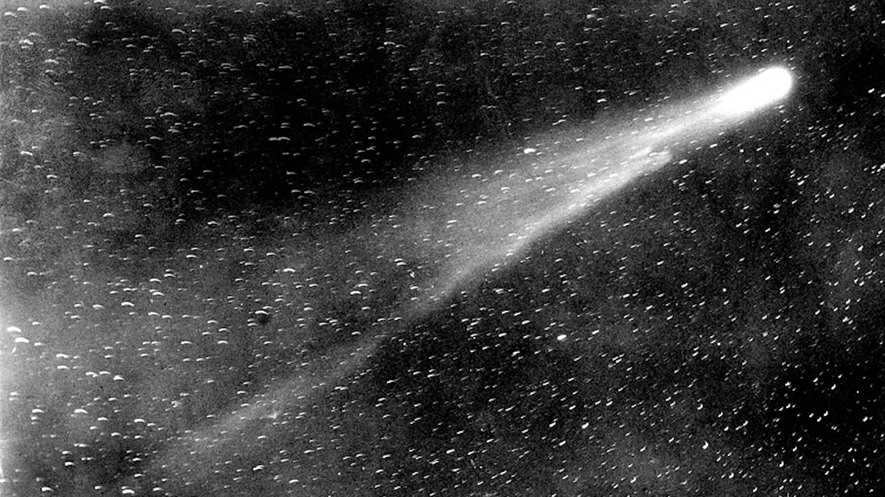
It is important to remember the distinctive tail of a comet, as it is a unique feature and serves as the comet’s trademark.
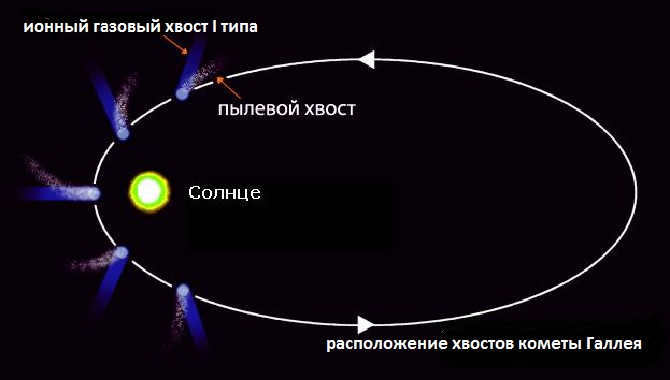
We can categorize comet tails into three distinct types:
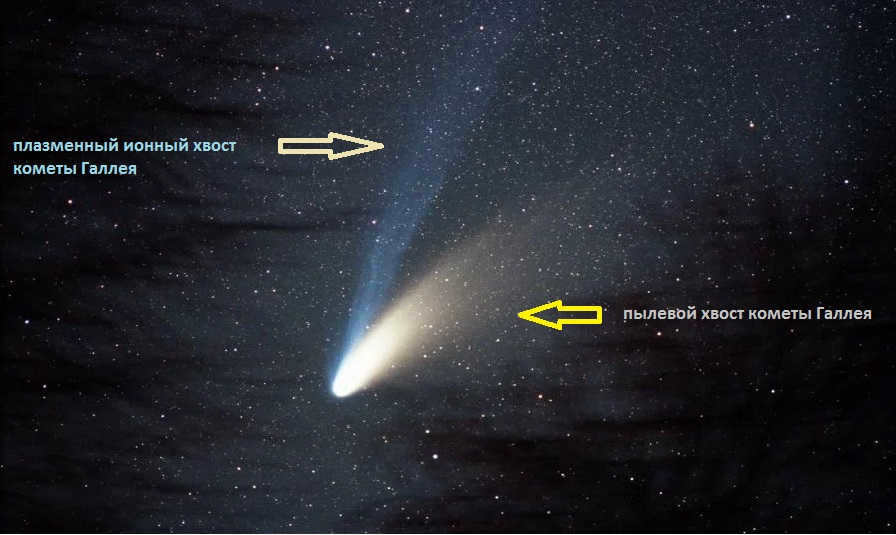
The impact of the solar wind on cometary dust, which consists of solid fragments, is relatively minor. Consequently, the dust particles disperse at a velocity determined by the combined effect of the acceleration imparted to them by the solar wind’s pressure and the comet’s initial orbital velocity. Hence, the dust tails trail significantly behind the ion tail, creating distinct type II and III tails that are oriented at an angle to the comet’s orbital path.
Comet dust tails are a temporary phenomenon, distinguished by their intensity and frequency of ejection. If the comet’s ion tail emits a violet glow, the dust tails of type II and III exhibit a reddish hue. Our current visitor is unique in that it displays all three types of tails. Astronomers have a good understanding of the first two types, but the third type was first observed in 1835. During its most recent visit, Halley’s Comet provided astronomers with the rare chance to observe both the first and second type of tails.
Analysis of the behavior of Halley’s Comet
Based on the observations made during the comet’s most recent visit, it is evident that this celestial object is quite active. The side of the comet that is exposed to the Sun appears to be a bubbling source of energy. The temperature on this sun-facing surface fluctuates between 30 and 130 degrees Celsius, while the rest of the comet’s nucleus experiences temperatures below 100 degrees. This significant difference in temperature readings suggests that only a small portion of the comet’s nucleus has a high albedo and can effectively absorb heat. The remaining 70-80% of the comet’s surface is covered in a dark substance that absorbs sunlight.
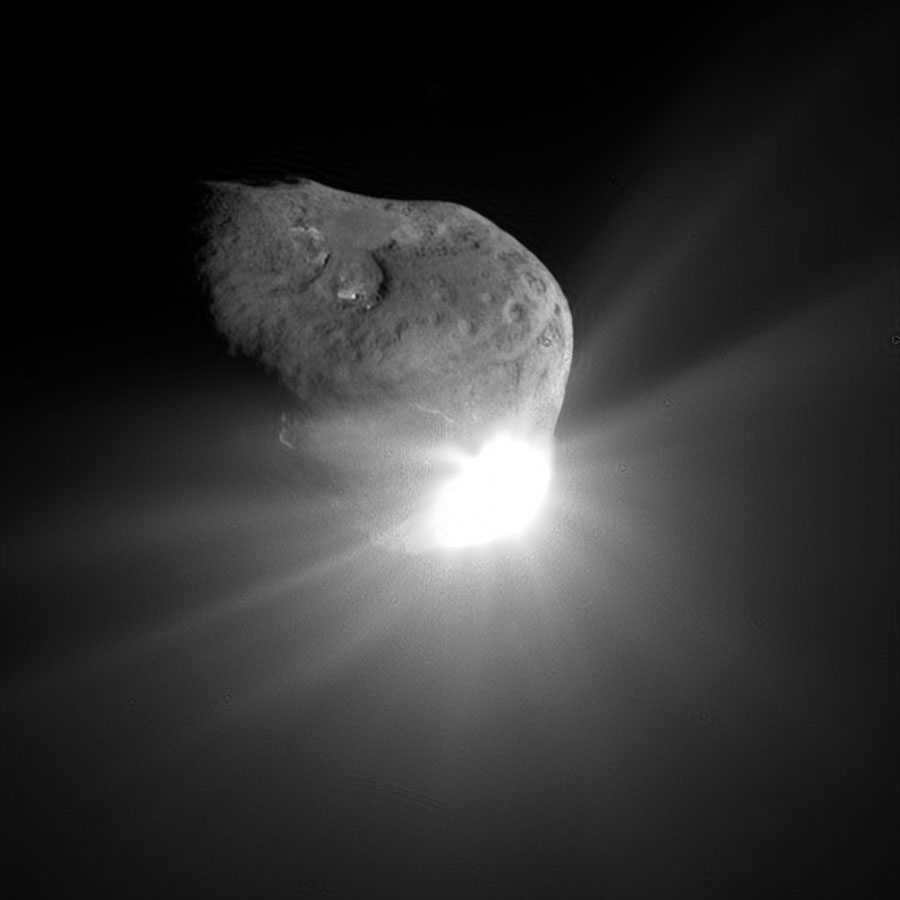
Research shows that the comet we are observing is composed of a combination of dirt and interstellar ice. The majority of its composition is water vapor, accounting for over 80% of its mass. The remaining 17% is made up of carbon monoxide, methane, nitrogen, and ammonia particles. Carbon dioxide only makes up a small percentage, around 3-4%.
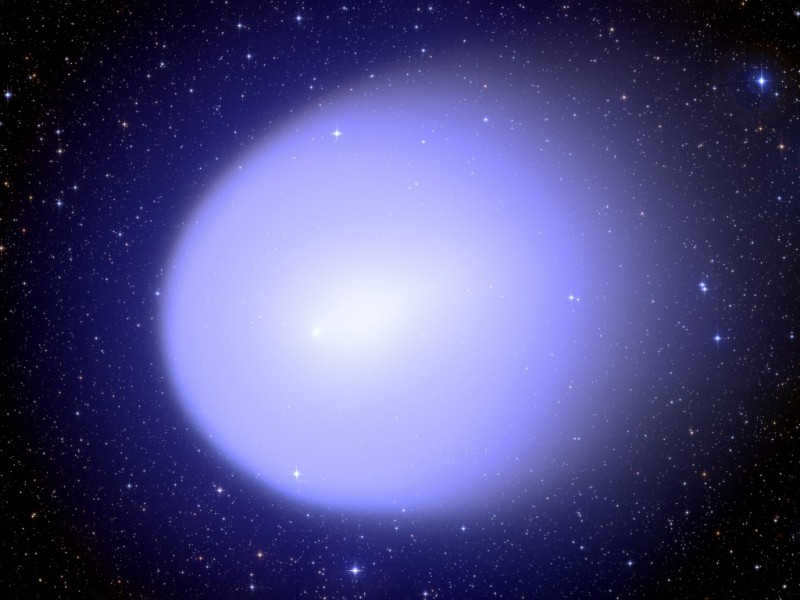
If we discuss the amount of material for life that this mass of soil and snow possesses, we can analyze Halley’s Comet from various perspectives. Scientific calculations, derived from information on 46 occurrences of the comet, support the notion that the celestial object’s existence is characterized by disorder and continuous fluctuations in response to external circumstances. In simpler terms, throughout its lifespan, the comet undergoes a state of dynamic chaos.
It is believed that Halley’s Comet has a lifespan of around 7-10 billion years. Scientists have determined that during its most recent visit to our vicinity in space, the comet’s nucleus has already shed up to 80% of its original mass. This suggests that the comet is now in its twilight years and may break apart into smaller fragments within a few thousand years. The grand finale of this remarkable existence could potentially occur within our solar system, within view of our eyes, or, conversely, unfold in the distant corners of our shared home.

Concluding Remarks
The most recent appearance of Halley’s Comet, which occurred in 1986 and had been eagerly anticipated for many years, proved to be a major letdown for numerous individuals. The primary cause for this widespread disappointment was the inability to observe the celestial object in the northern hemisphere. All the preparations made for this highly anticipated event ended up being in vain. Furthermore, the observation window for the comet was extremely brief, resulting in only a limited number of observations being recorded by scientists worldwide. A few days later, the comet disappeared behind the sun’s disc. The next encounter with this cosmic visitor was postponed for another 76 years.
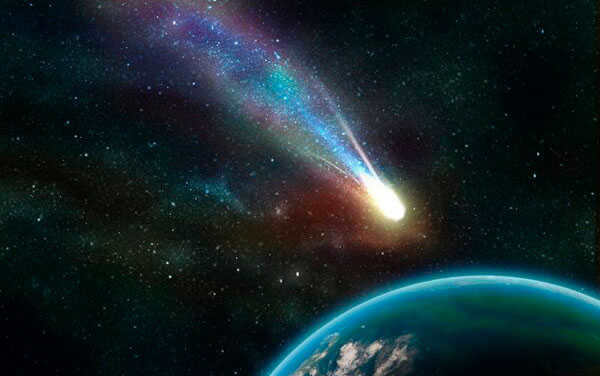
Halley is the sole short-period comet that is visible to the unaided eye. For this reason, individuals have had the ability to witness it in the nighttime heavens since ancient eras. The comet makes its way towards the Sun once every 75 to 76 years from the Oort Cloud. According to scientists, this is the birthplace of comets.
Halley is the first known comet to have a regular orbit in the history of space exploration. Prior to the Renaissance, European scientists followed Aristotle’s belief that comets were disturbances in the Earth’s atmosphere. However, ancient philosophers had made various assumptions about the nature of these celestial bodies.
In the 1st century AD, Seneca was the first to attempt proving the periodic movement of comets. It was astronomer Edmund Halley who ultimately predicted and confirmed the periodicity of comets. He used mathematical calculations to determine the comet’s return time. According to his calculations, the comet’s orbit around the Sun varies between 74 and 79 years, with an average period of 76 years.
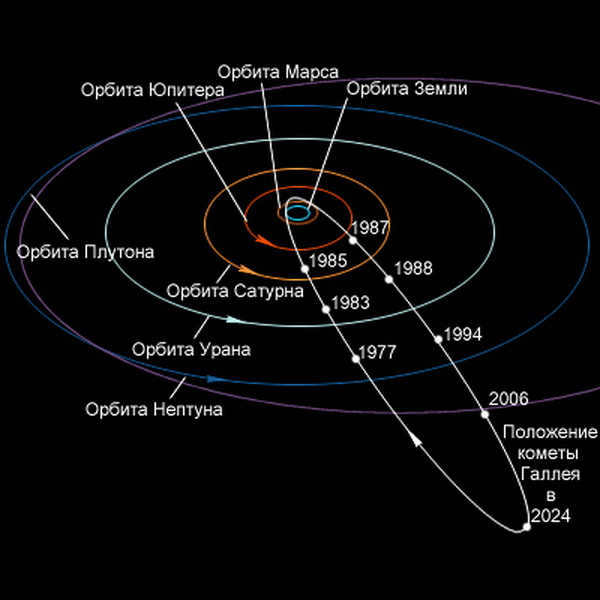
During the years 1680-1681, a young Halley, aged 24, made observations of a brilliant comet, often referred to as Newton’s comet. Initially, it approached the Sun and then veered away, challenging the prevailing belief of straight-line motion.
While delving into this matter, Halley came to the realization that the centripetal force exerted on the comet by the Sun should decrease in an inverse proportion to the square of the distance.
Based on the discovered period and making rough estimations of the influence from larger planets, the scientist successfully predicted the comet’s return in 1758.
Although Halley’s prediction was ultimately proven correct, it took until December 25, 1758 for the comet to be officially detected. It was an observant German peasant and amateur astronomer named I. Palich who first noticed its presence.
The comet’s perihelion passage didn’t occur until March 13, 1759, which was a delay of 618 days. This delay was caused by perturbations resulting from the gravitational attraction of Jupiter and Saturn. A. Clerot, with the assistance of J. Lalande, Mme. Lalande, and Madame N.-R. Lepot, had pre-calculated the delay two months before the comet’s reappearance. Remarkably, the margin of error in their calculations was just 31 days.

Halley passed away in 1742, before having the chance to witness the reappearance of the celestial body. The confirmation of the comet’s return was a groundbreaking revelation, as it proved that celestial bodies other than planets could also revolve around the Sun. As a tribute to Halley’s contributions, French astronomer N. Lacaille bestowed the comet with his name in 1759.
Noteworthy Sightings of the Celestial Object
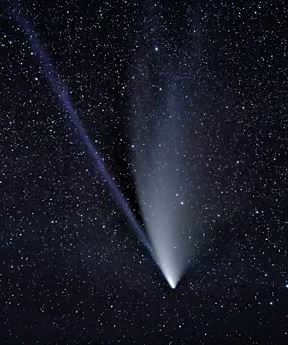

Halley’s Comet is one-of-a-kind because it has been mentioned in historical sources for at least 30 of its appearances since the earliest observations. The earliest reliable observation can be traced back to 240 BC.
The Chinese dynastic “Book of Wei” and several Byzantine chronicles documented a description of the comet in 530. However, the first scientific observation for studying it occurred in 1456.
The most significant observations of the comet were conducted by Paolo Toscanelli, an Italian physician and astronomer, who measured its coordinates every day from June 8 to July 8.
An anonymous treatise called De Cometa was written for Roman Pope Paul II in 1468. This treatise included observations and the calculation of the comet’s coordinates.
Peter Apian discovered in 1531 that the tail of the comet always pointed away from the Sun. Johannes Kepler observed a comet in 1607 and concluded that it was moving in a straight line through the solar system.


In 1759, Halley’s Comet made its first predicted appearance, passing through perihelion on March 13th of that year. By the time the comet reappeared in 1835, astronomers were not only able to predict the date of its perihelion passage, but also calculate its ephemeris.
In December 1834, astronomers began using telescopes to search for the comet. On August 6, 1835, S. Dumouchel, the director of a small observatory in Rome, discovered Halley’s Comet as a faint dot. A few weeks later, on August 20, V. J. Struve rediscovered the comet in Dorpat and was able to observe it with the naked eye two days later.
The comet achieved a stellar magnitude of 1 in October, accompanied by a tail spanning approximately 20 degrees.
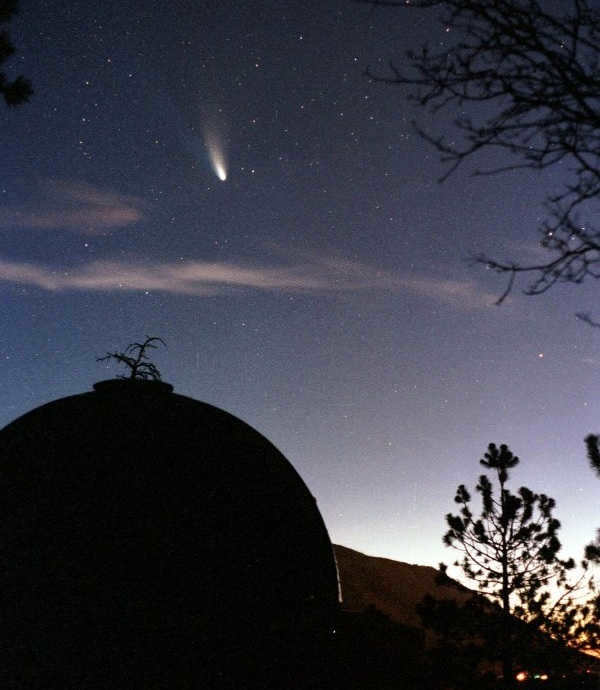
V. Y. Struve, while in Derpt, and J. Herschel, during the expedition to the Cape of Good Hope, made numerous drawings of the comet, which underwent constant changes in its appearance.
Bessel, who also tracked the comet, came to the conclusion that its movement was significantly influenced by the non-gravitational reactive forces of the gases vaporizing from its surface.
On September 17, V. J. Struve observed a star being covered by the head of the comet. No change in the star’s brightness was recorded, leading to the conclusion that the matter of the head was extremely rarefied and the central nucleus was extremely small.
When Halley made its appearance in 1910, it was captured in photographs for the first time and its composition was studied through spectral data.
At its closest point to Earth, Halley was only 0.15 astronomical units away, creating a stunning sight in the night sky. The comet was first observed during its approach on September 11, 1909, by M. Wolf in Heidelberg using a 72 cm telescope-reflector with a camera. It appeared as a celestial object with a magnitude of 16-17 stars.
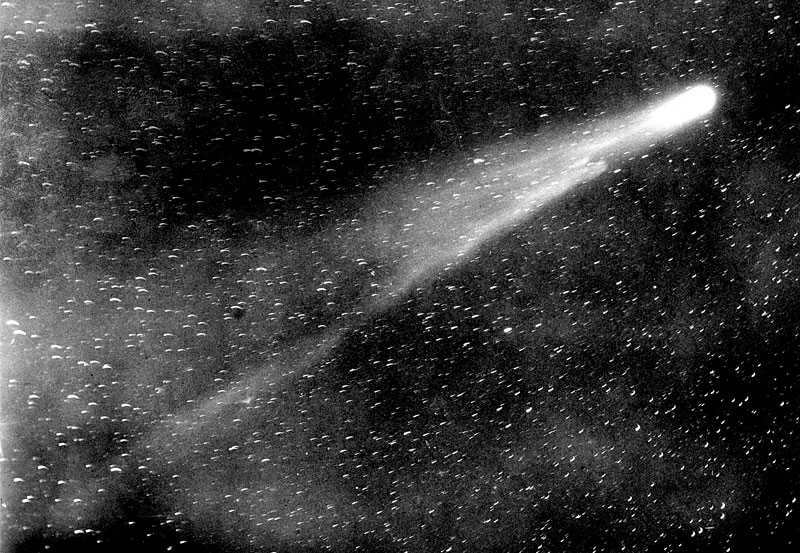

Image of Halley’s Comet in 1910
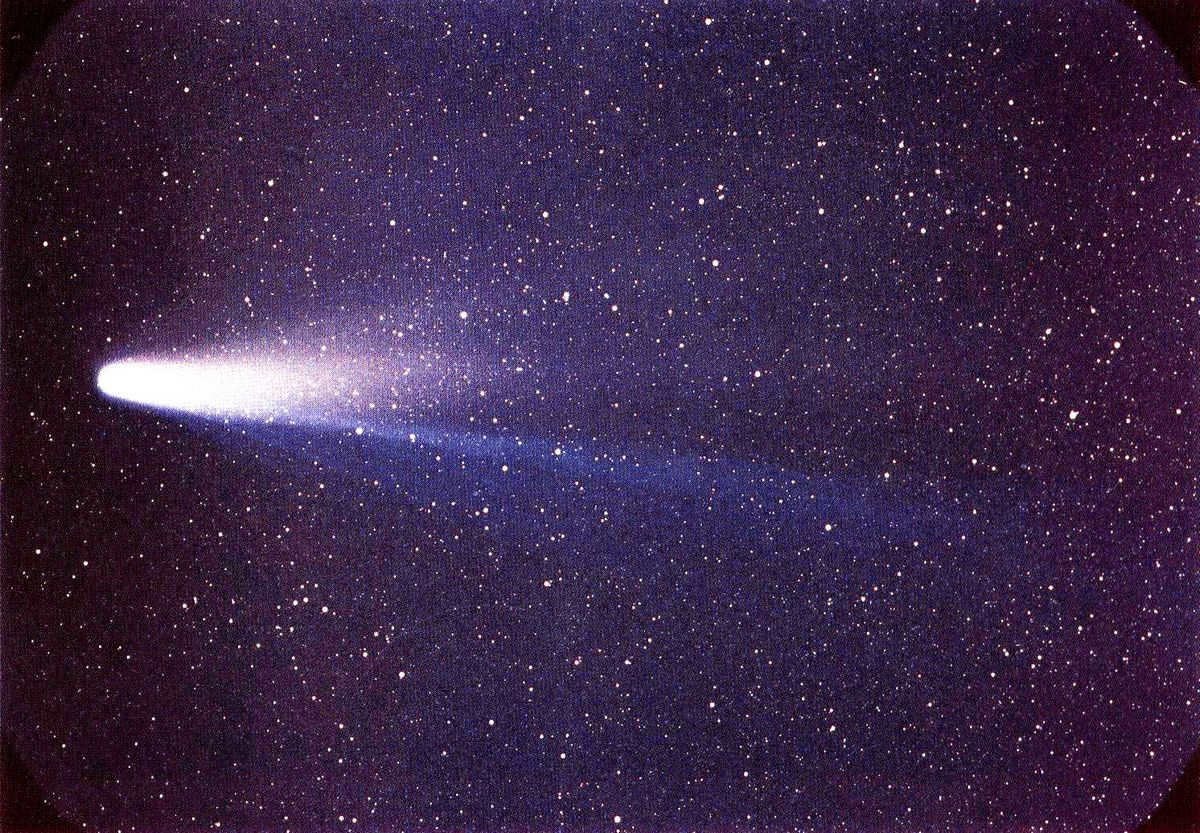

A photograph capturing Halley’s Comet on March 8, 1986
A more faint image was subsequently discovered on a photographic plate captured on August 28. The comet reached its closest point to the Sun, known as perihelion, on April 20 (3 days later than the predictions made by F. H. Cowell and E. C. D. Crommelin), and it presented a magnificent spectacle in the early morning sky in early May. During this time, Venus passed through the comet’s tail.
On May 18, the comet positioned itself between the Sun and Earth, causing Earth to briefly enter the comet’s tail, which always points away from the Sun. On the same day, the comet crossed the Sun’s disk.
Observations in Moscow were conducted by V. K. Cerasky and P. K. Sternberg using a refractor with a resolution of 0.2-0.3″. However, due to the comet being situated 23 million km away, they were unable to discern its nuclei. Based on this, it was deduced that the size of the nucleus was less than 20-30 km.
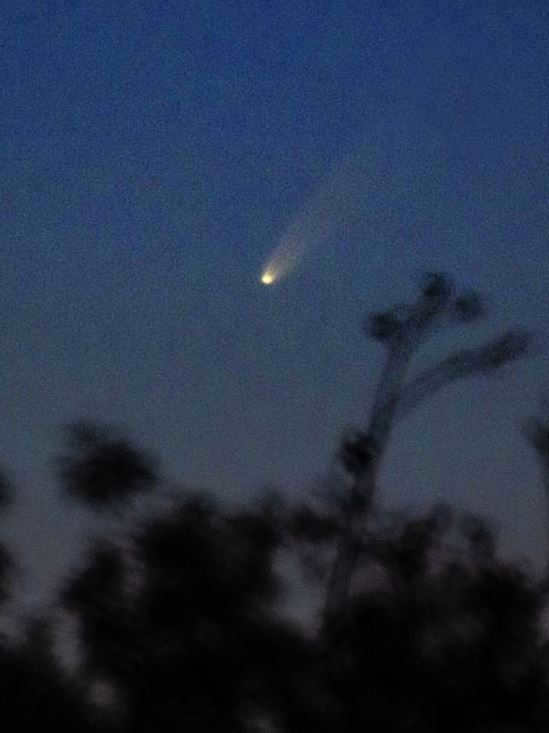
The Athens observations yielded the same result. The accuracy of this estimation (the maximum size of the nucleus turned out to be approximately 15 km) was confirmed during the subsequent appearance, when the nucleus could be studied up close by spacecraft.
By the end of May to the beginning of June 1910, the comet had a stellar magnitude of 1 and the tail measured about 30 degrees in length. It started to rapidly move away after May 20, but was documented photographically until June 16, 1911.
On the 18th of May, 1910, there was a revelation that the Earth would intersect with the trail of a comet. This revelation led to widespread predictions of the apocalypse, causing panic and a frantic desire for fraudulent “anticomet pills” and “anticomet umbrellas”. However, numerous astronomers were swift to clarify that the comet’s trail is so thinly spread that it would have no detrimental impact on the Earth’s atmosphere.


Various observations and studies of the atmosphere were conducted on May 18 and subsequent days, but no effects attributable to the presence of cometary matter were detected.
In February, during the comet’s closest approach to the Sun, Earth and Halley’s Comet were on opposite sides of the Sun, making it impossible to observe the comet during its brightest phase when the tail was at its largest. Additionally, due to increased light pollution caused by urbanization since its last appearance, the majority of the population was unable to observe the comet at all.
Moreover, during the months of March and April, the comet was so luminous that it appeared virtually undetectable in the Northern Hemisphere of our planet.

Between 1984 and 1987, there were two observation programs dedicated to studying the comet: the Soviet SoProG and The International Halley Watch. Once the exploration program for Venus had concluded, the Soviet interplanetary stations Vega-1 and Vega-2 were sent to fly past the comet.
Vega-1 began transmitting images of Halley’s comet on March 4, 1986, from a distance of 14 million km. It was through this spacecraft that the nucleus of the comet was observed for the first time in history.
On March 6, the spacecraft flew past the comet at a distance of 8879 km. During the flyby, the spacecraft was hit by cometary particles at a collision velocity of approximately 78 km/s, resulting in a 45% decrease in the power of the solar panels. However, the spacecraft remained operational.
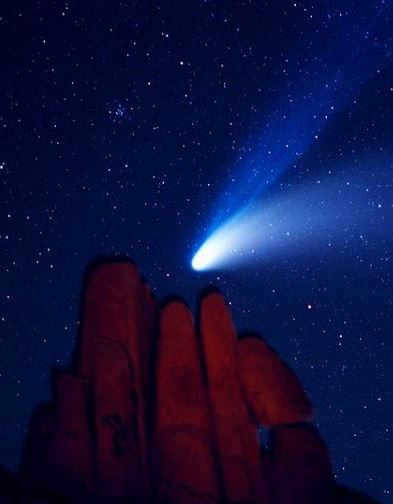
“Vega-2” passed by the comet at a distance of 8045 km on March 9th. In total, over 1500 images were transmitted to Earth by the instruments.
As part of the collaborative research program, the measurement data from the two Soviet stations were utilized to adjust the orbit of the European Space Agency’s Giotto space probe, which managed to approach the comet at a distance of 605 km on March 14th.
Two Japanese spacecraft, Suisei (March 8th, 150,000 km) and Sakigake (March 10th, 7 million km, used for guiding the previous spacecraft), also made valuable contributions to the study of Halley’s Comet.
The group of five spacecraft involved in the exploration of the comet became unofficially known as “Halley’s Armada”.
The last time the comet came close to Earth, it was seen from March 6-8, 2003, by three ESO Very Large Telescopes at Cerro Paranal, Chile. At that time, it had a brightness level of 28.2 and had completed 4/5 of its journey to the farthest point in its orbit.
These telescopes observed the comet at a distance that was a record for comets (28.06 a. e., or 4200 million kilometers). This observation helped scientists improve their methods for detecting very faint objects beyond Neptune.
Orbit
The Orbit is a celestial phenomenon that involves the movement of an object, such as a planet or a satellite, around another object due to the force of gravity. This mesmerizing dance of celestial bodies has fascinated scientists and stargazers alike for centuries.
Orbiting is not limited to our own planet. In fact, almost everything in the universe is in some kind of orbit. From the moon orbiting the Earth to the Earth orbiting the sun, and even galaxies orbiting each other, the concept of orbit is pervasive in the vast expanse of space.
Understanding the mechanics of orbit is crucial for space exploration and satellite technology. By calculating the speed and trajectory required to achieve a stable orbit, scientists and engineers can send satellites into space to gather data, communicate with distant locations, and even provide weather forecasts.
Orbits can be classified into different types based on their shape and characteristics. The most common type is the elliptical orbit, which resembles an elongated circle. Other types include circular orbits, geostationary orbits, and polar orbits.
While orbits are primarily governed by the force of gravity, other factors can influence their behavior. For example, the presence of other objects in the vicinity can cause gravitational interactions that alter the shape or stability of an orbit.
Overall, the concept of orbit is a fundamental aspect of our understanding of the universe. It allows us to explore the cosmos, communicate across vast distances, and marvel at the beauty of celestial bodies dancing in space.
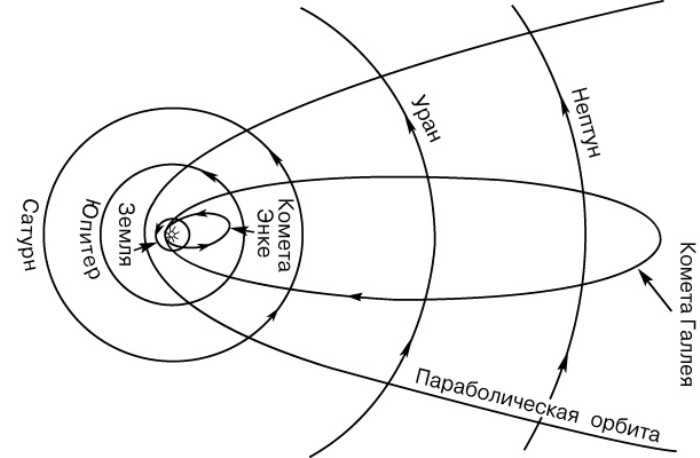
The comet is in a highly elongated elliptical orbit with an eccentricity of 0.967. On its previous appearance, it had a perihelion distance to the Sun of 0.587 a. e. (between Mercury and Venus) and an aphelion distance of more than 35 a. e. Variations in period and orbital elements are caused by the gravitational influence of the larger planets that the comet passes by.
The comet’s orbit is inclined at an angle of 162.5 degrees to the ecliptic plane. Unlike most objects in the solar system, it moves in the opposite direction to the planets and is inclined at an angle of 17.5 degrees to the Earth’s orbit (180-162.5=17.5 degrees). The comet’s perihelion is elevated by 0.17 a. e. above the ecliptic plane.
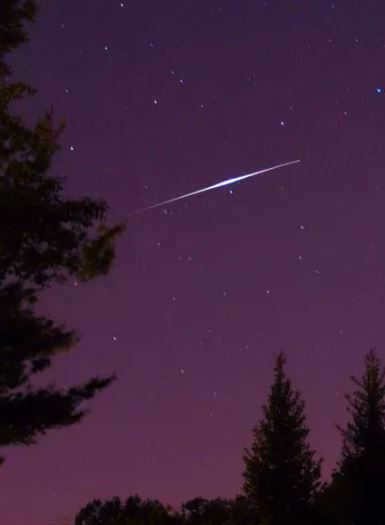

Halley’s Comet has one of the highest velocities relative to Earth among all the bodies in the Solar System, thanks to its highly eccentric orbit. During its 1910 approach, it reached a staggering speed of 70.56 km/s.
Because the comet’s orbit intersects Earth’s orbit at two points, it leaves behind dust that forms two meteor showers visible from Earth: the Etha-Aquariids in early May and the Orionids in late October.
The numerical modeling results suggest that Halley’s Comet has maintained its current orbit for a duration ranging from 16,000 to 200,000 years. It is, however, challenging to obtain an accurate numerical integration of the orbit due to the emergence of instabilities caused by the perturbation of the planets over a time span exceeding a few tens of revolutions.
Furthermore, the motion of the comet is significantly influenced by non-gravitational effects. As it approaches the Sun, Halley’s Comet emits jets of gas that sublimate from its surface. This emission results in jet recoil and subsequent orbital changes. Consequently, these variations in motion can result in deviations in the time it takes for the comet to pass through perihelion, with discrepancies of up to four days.
Composition
The composition of the comet’s surface was examined during the Vega and Giotto missions. When the comet gets closer to the Sun, volatile elements such as water, carbon monoxide, methane, nitrogen, and potentially other frozen gases, which have a low boiling point, begin to evaporate from the nucleus. This phenomenon results in the creation of a coma, which can have a diameter of up to 100,000 kilometers.
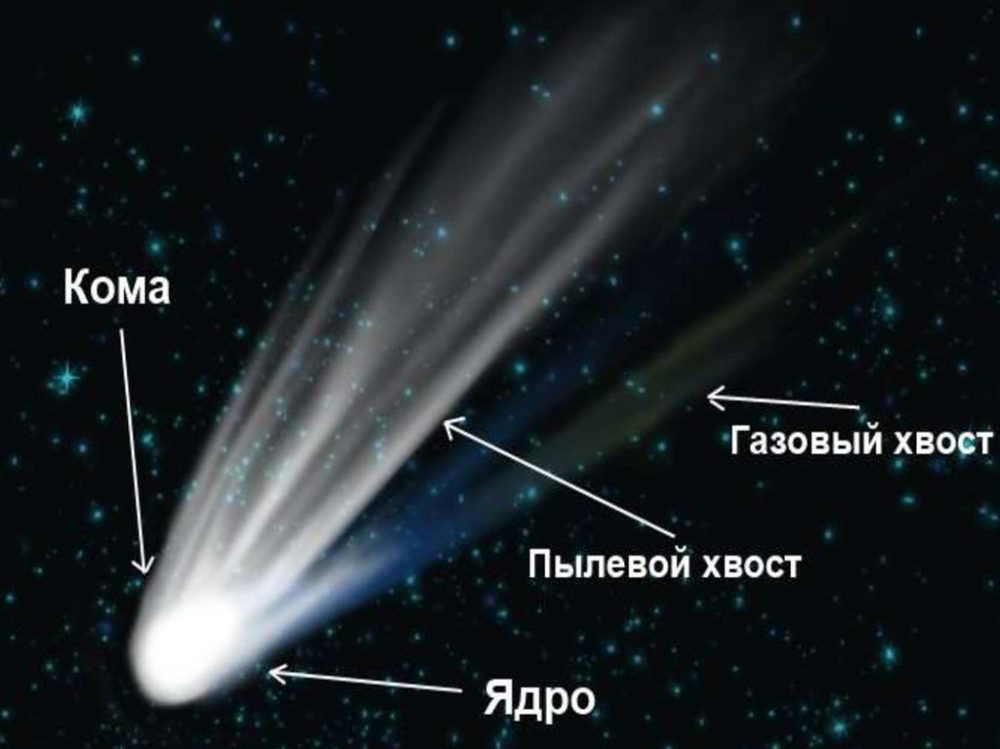
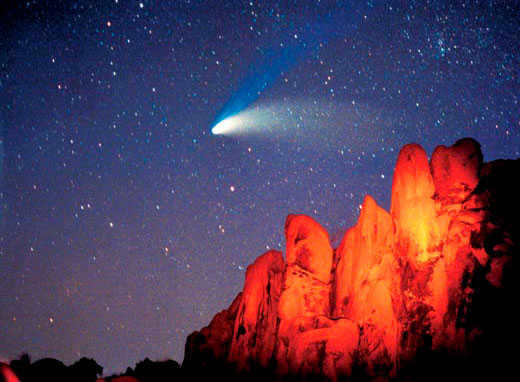
The sublimation of this contaminated ice results in the liberation of particulate matter that is connected to gas emanating from the nucleus. The gas molecules within the coma assimilate solar radiation and subsequently emit it at varying wavelengths, whereas the particulate matter scatters solar radiation in multiple directions without altering its wavelength. These phenomena cause the coma to become perceptible to the viewer.
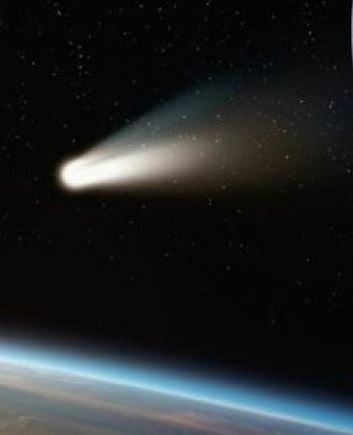
However, the behavior of dust and gas in the tail is different.
The gas molecules in the tail are ionized by ultraviolet radiation from the Sun, and the ions are pushed by the solar wind, which is a stream of charged particles emitted by the Sun. This causes the coma to be pulled into the comet’s long tail, which can reach lengths of over 100 million kilometers.
Changes in the flow of the solar wind can even lead to rapid changes in the appearance of the tail and can even cause it to break partially or completely.
The solar wind accelerates the ions to speeds of tens and hundreds of kilometers per second, many of which exceed the comet’s orbital velocity. As a result, their movement is primarily away from the Sun, just like the type I tail they create.
Despite the comet’s coma being quite large, Halley’s Comet’s nucleus is relatively small and has an irregular shape resembling a potato, measuring approximately 15x8x8 kilometers.
The mass of the nucleus is also relatively small, estimated to be around 2.2-10 kg, with an average density of about 600 kg/m. This suggests that the nucleus is likely composed of numerous loosely connected fragments, forming a pile of debris.
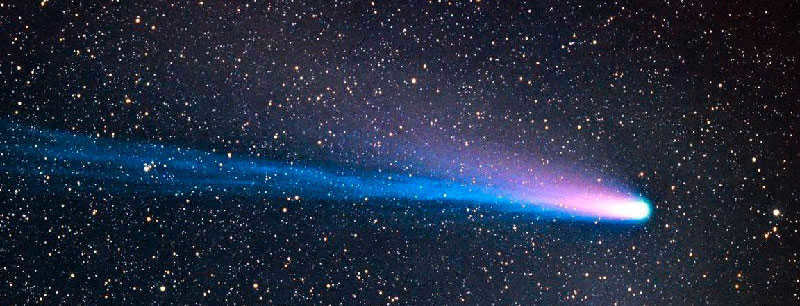
The rotation of Halley’s Comet is quite complex due to its irregularly shaped nucleus. Although only a quarter of the comet’s nucleus surface has been observed in detail during space missions, these observations have revealed a highly intricate topography consisting of hills, depressions, mountain ranges, and at least one crater.
Through spacecraft studies, it has been determined that the nucleus emits gases that are predominantly composed of water vapor (approximately 80%), with carbon monoxide making up about 17% and carbon dioxide making up 3-4%. There are also traces of methane, although more recent studies have shown a decrease in carbon monoxide to only 10% and the presence of additional traces of methane and ammonia.
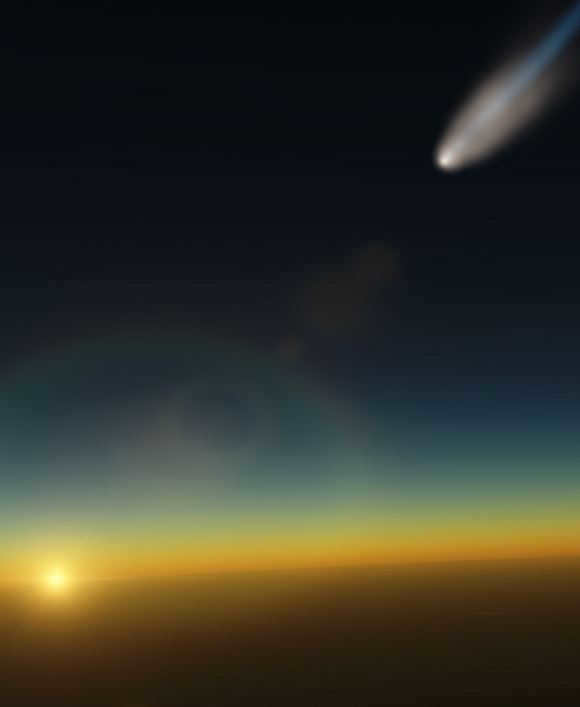
Scientists have made a groundbreaking discovery, revealing that the particles of dust consist primarily of a mixture of compounds composed of carbon, hydrogen, oxygen, and nitrogen. These compounds are commonly found outside of our solar system, along with silicates, which are the building blocks of Earth’s rocks.
Initially, researchers believed that the ratio of deuterium to hydrogen in the water vapor released from the comet’s surface would be similar to that observed in Earth’s oceans. This finding suggested that comets of the same type might have delivered water to our planet in the ancient past.
However, subsequent observations have disproven this hypothesis. It has been found that the deuterium content in the comet’s nucleus is significantly higher than that of Earth’s water. As a result, it is now highly unlikely that comets played a role in providing Earth with its water.
Frequently Asked Questions
The occurrence of Halley’s Comet passing close to the planets is not a common event. Its dynamics are primarily influenced by Jupiter and Saturn, so the chaotic component is only evident over thousands of years. During observations up until the 15th century, efforts were made to avoid the larger planets, allowing its periodic tendencies to be observed. This led to the discovery of the “Chinese periodic law” by the authors of the NH. Calculations for the middle of the first millennium B.C. are not very reliable and may have an error of about a month. Additionally, calculating appearances of the comet even further back in time without significant refinement of its orbit is generally meaningless.
In December 2023, the comet is set to reach aphelion, and it will then start moving towards the Sun once again. Scientists are anticipating the arrival of the comet in 2061. It is quite an achievement for many adults to still be alive at that time. The passage is expected to take place on July 28 during the summer, and the comet will be on the Earth’s side. This event is believed to be one of the most remarkable occurrences in the field of astronomy. On September 9, 2060, Halley’s Comet will pass by Jupiter at a distance of 0.98 astronomical units. Then, on August 20, 2061, it will approach Venus at a distance of 0.0543 astronomical units (equivalent to 8.1 million kilometers). In the year 2134, it is predicted that Halley’s Comet will pass by Earth at a distance of 0.09 astronomical units (approximately 13.6 million kilometers). During this appearance, its apparent magnitude will be around -2.0.
According to recent research, Halley’s Comet is expected to have a lifespan of around 10 million years. However, new findings suggest that within a few tens of millennia, it may either evaporate, split into two separate comets, or even be expelled from the solar system within a few hundred thousand years. Over the course of the past 2,000-3,000 orbital returns, the mass of Halley’s Comet’s nucleus has diminished by approximately 80-90%.

